Student Assessment Workbook
VerifiedAdded on 2023/01/13
|29
|10642
|48
AI Summary
This document is the Student Assessment Workbook for CHC50113 Diploma of Early Childhood Education and Care. It provides instructions and tasks for students to demonstrate their competence in facilitating compliance in an education and care service.
Contribute Materials
Your contribution can guide someone’s learning journey. Share your
documents today.
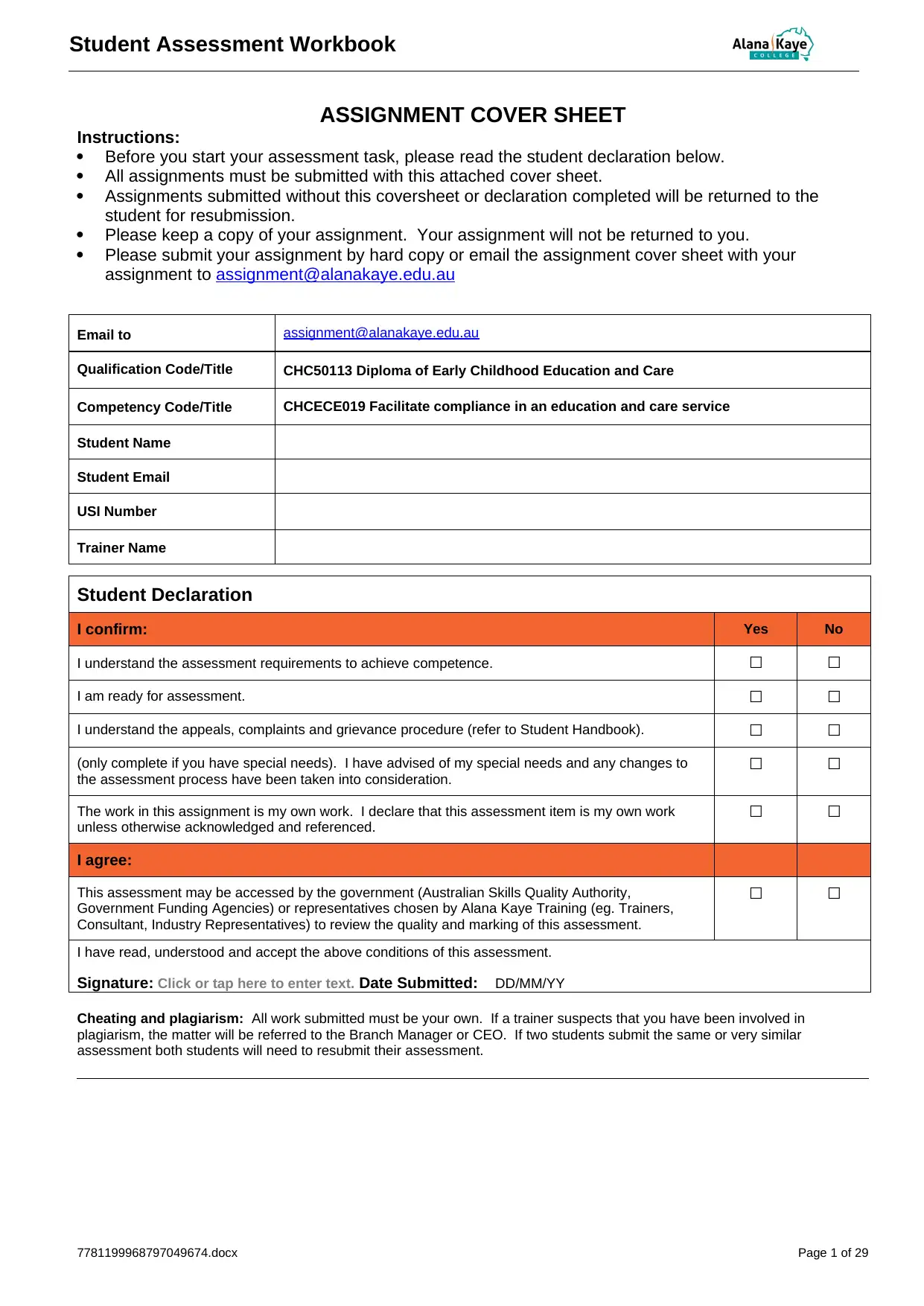
Student Assessment Workbook
ASSIGNMENT COVER SHEET
Instructions:
Before you start your assessment task, please read the student declaration below.
All assignments must be submitted with this attached cover sheet.
Assignments submitted without this coversheet or declaration completed will be returned to the
student for resubmission.
Please keep a copy of your assignment. Your assignment will not be returned to you.
Please submit your assignment by hard copy or email the assignment cover sheet with your
assignment to assignment@alanakaye.edu.au
Email to assignment@alanakaye.edu.au
Qualification Code/Title CHC50113 Diploma of Early Childhood Education and Care
Competency Code/Title CHCECE019 Facilitate compliance in an education and care service
Student Name
Student Email
USI Number
Trainer Name
Student Declaration
I confirm: Yes No
I understand the assessment requirements to achieve competence. ☐ ☐
I am ready for assessment. ☐ ☐
I understand the appeals, complaints and grievance procedure (refer to Student Handbook). ☐ ☐
(only complete if you have special needs). I have advised of my special needs and any changes to
the assessment process have been taken into consideration.
☐ ☐
The work in this assignment is my own work. I declare that this assessment item is my own work
unless otherwise acknowledged and referenced.
☐ ☐
I agree:
This assessment may be accessed by the government (Australian Skills Quality Authority,
Government Funding Agencies) or representatives chosen by Alana Kaye Training (eg. Trainers,
Consultant, Industry Representatives) to review the quality and marking of this assessment.
☐ ☐
I have read, understood and accept the above conditions of this assessment.
Signature: Click or tap here to enter text. Date Submitted: DD/MM/YY
Cheating and plagiarism: All work submitted must be your own. If a trainer suspects that you have been involved in
plagiarism, the matter will be referred to the Branch Manager or CEO. If two students submit the same or very similar
assessment both students will need to resubmit their assessment.
7781199968797049674.docx Page 1 of 29
ASSIGNMENT COVER SHEET
Instructions:
Before you start your assessment task, please read the student declaration below.
All assignments must be submitted with this attached cover sheet.
Assignments submitted without this coversheet or declaration completed will be returned to the
student for resubmission.
Please keep a copy of your assignment. Your assignment will not be returned to you.
Please submit your assignment by hard copy or email the assignment cover sheet with your
assignment to assignment@alanakaye.edu.au
Email to assignment@alanakaye.edu.au
Qualification Code/Title CHC50113 Diploma of Early Childhood Education and Care
Competency Code/Title CHCECE019 Facilitate compliance in an education and care service
Student Name
Student Email
USI Number
Trainer Name
Student Declaration
I confirm: Yes No
I understand the assessment requirements to achieve competence. ☐ ☐
I am ready for assessment. ☐ ☐
I understand the appeals, complaints and grievance procedure (refer to Student Handbook). ☐ ☐
(only complete if you have special needs). I have advised of my special needs and any changes to
the assessment process have been taken into consideration.
☐ ☐
The work in this assignment is my own work. I declare that this assessment item is my own work
unless otherwise acknowledged and referenced.
☐ ☐
I agree:
This assessment may be accessed by the government (Australian Skills Quality Authority,
Government Funding Agencies) or representatives chosen by Alana Kaye Training (eg. Trainers,
Consultant, Industry Representatives) to review the quality and marking of this assessment.
☐ ☐
I have read, understood and accept the above conditions of this assessment.
Signature: Click or tap here to enter text. Date Submitted: DD/MM/YY
Cheating and plagiarism: All work submitted must be your own. If a trainer suspects that you have been involved in
plagiarism, the matter will be referred to the Branch Manager or CEO. If two students submit the same or very similar
assessment both students will need to resubmit their assessment.
7781199968797049674.docx Page 1 of 29
Secure Best Marks with AI Grader
Need help grading? Try our AI Grader for instant feedback on your assignments.
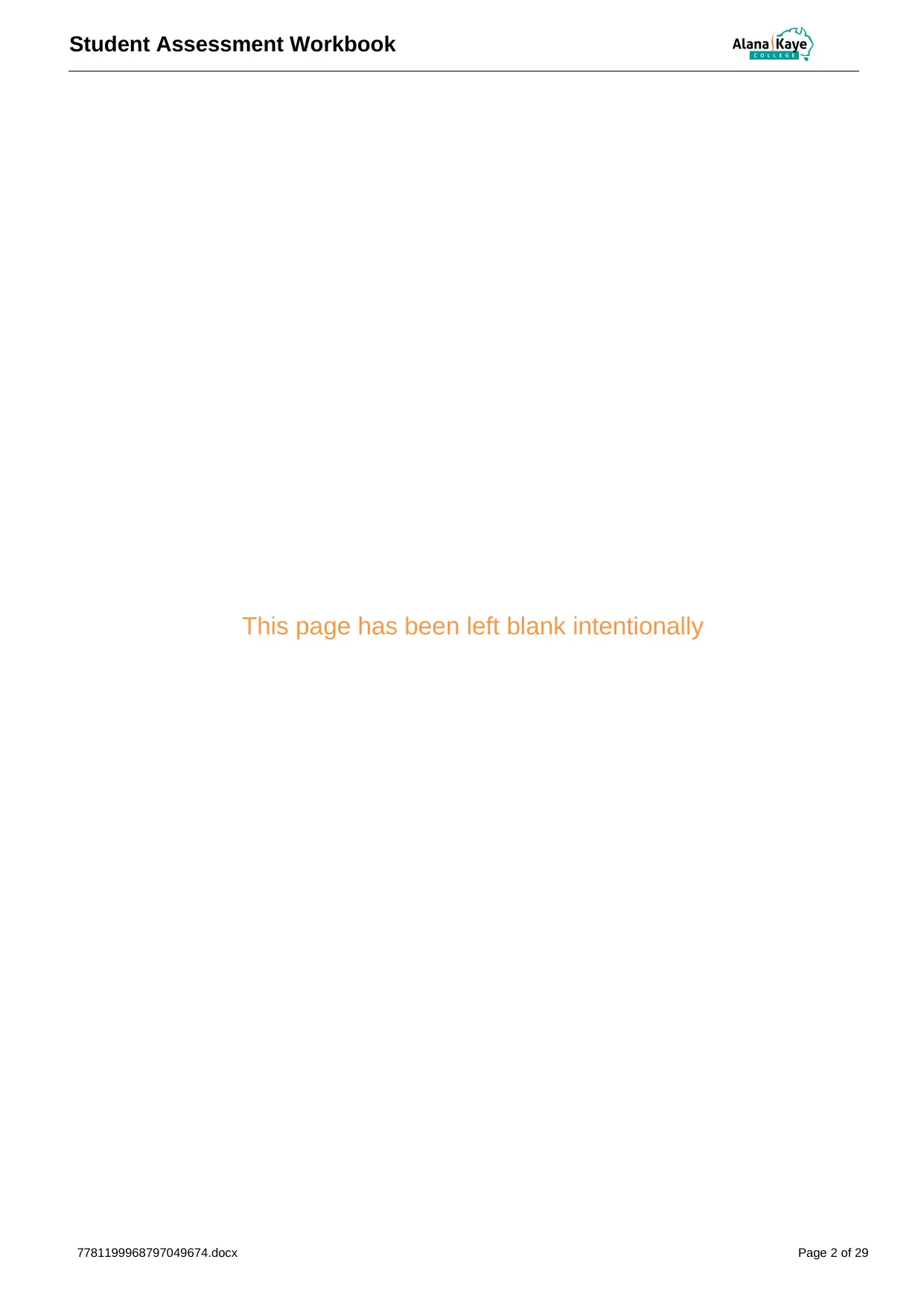
Student Assessment Workbook
This page has been left blank intentionally
7781199968797049674.docx Page 2 of 29
This page has been left blank intentionally
7781199968797049674.docx Page 2 of 29
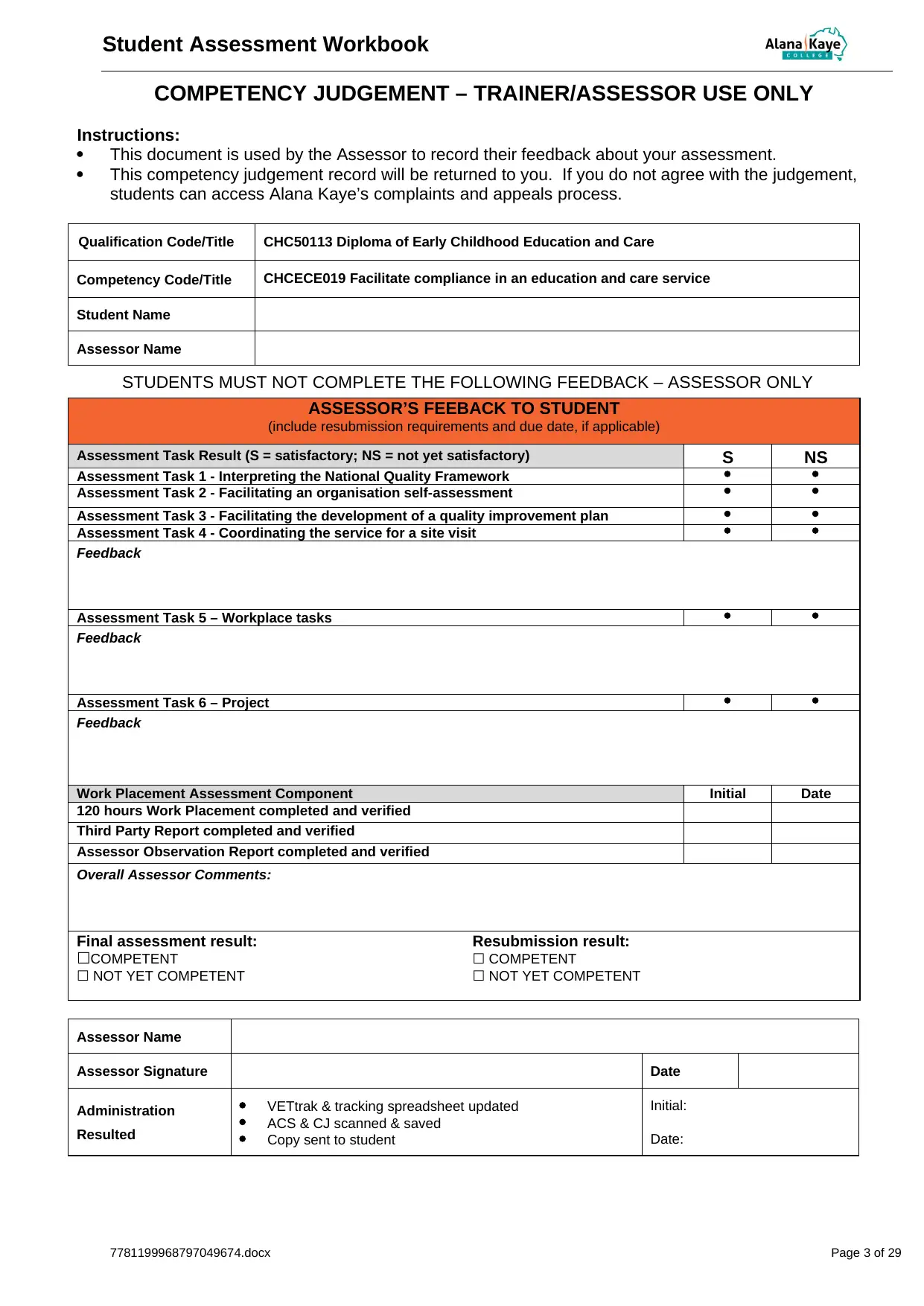
Student Assessment Workbook
COMPETENCY JUDGEMENT – TRAINER/ASSESSOR USE ONLY
Instructions:
This document is used by the Assessor to record their feedback about your assessment.
This competency judgement record will be returned to you. If you do not agree with the judgement,
students can access Alana Kaye’s complaints and appeals process.
Qualification Code/Title CHC50113 Diploma of Early Childhood Education and Care
Competency Code/Title CHCECE019 Facilitate compliance in an education and care service
Student Name
Assessor Name
STUDENTS MUST NOT COMPLETE THE FOLLOWING FEEDBACK – ASSESSOR ONLY
ASSESSOR’S FEEBACK TO STUDENT
(include resubmission requirements and due date, if applicable)
Assessment Task Result (S = satisfactory; NS = not yet satisfactory) S NS
Assessment Task 1 - Interpreting the National Quality Framework
Assessment Task 2 - Facilitating an organisation self-assessment
Assessment Task 3 - Facilitating the development of a quality improvement plan
Assessment Task 4 - Coordinating the service for a site visit
Feedback
Assessment Task 5 – Workplace tasks
Feedback
Assessment Task 6 – Project
Feedback
Work Placement Assessment Component Initial Date
120 hours Work Placement completed and verified
Third Party Report completed and verified
Assessor Observation Report completed and verified
Overall Assessor Comments:
Final assessment result: Resubmission result:
☐COMPETENT ☐ COMPETENT
☐ NOT YET COMPETENT ☐ NOT YET COMPETENT
Assessor Name
Assessor Signature Date
Administration
Resulted
VETtrak & tracking spreadsheet updated
ACS & CJ scanned & saved
Copy sent to student
Initial:
Date:
7781199968797049674.docx Page 3 of 29
COMPETENCY JUDGEMENT – TRAINER/ASSESSOR USE ONLY
Instructions:
This document is used by the Assessor to record their feedback about your assessment.
This competency judgement record will be returned to you. If you do not agree with the judgement,
students can access Alana Kaye’s complaints and appeals process.
Qualification Code/Title CHC50113 Diploma of Early Childhood Education and Care
Competency Code/Title CHCECE019 Facilitate compliance in an education and care service
Student Name
Assessor Name
STUDENTS MUST NOT COMPLETE THE FOLLOWING FEEDBACK – ASSESSOR ONLY
ASSESSOR’S FEEBACK TO STUDENT
(include resubmission requirements and due date, if applicable)
Assessment Task Result (S = satisfactory; NS = not yet satisfactory) S NS
Assessment Task 1 - Interpreting the National Quality Framework
Assessment Task 2 - Facilitating an organisation self-assessment
Assessment Task 3 - Facilitating the development of a quality improvement plan
Assessment Task 4 - Coordinating the service for a site visit
Feedback
Assessment Task 5 – Workplace tasks
Feedback
Assessment Task 6 – Project
Feedback
Work Placement Assessment Component Initial Date
120 hours Work Placement completed and verified
Third Party Report completed and verified
Assessor Observation Report completed and verified
Overall Assessor Comments:
Final assessment result: Resubmission result:
☐COMPETENT ☐ COMPETENT
☐ NOT YET COMPETENT ☐ NOT YET COMPETENT
Assessor Name
Assessor Signature Date
Administration
Resulted
VETtrak & tracking spreadsheet updated
ACS & CJ scanned & saved
Copy sent to student
Initial:
Date:
7781199968797049674.docx Page 3 of 29
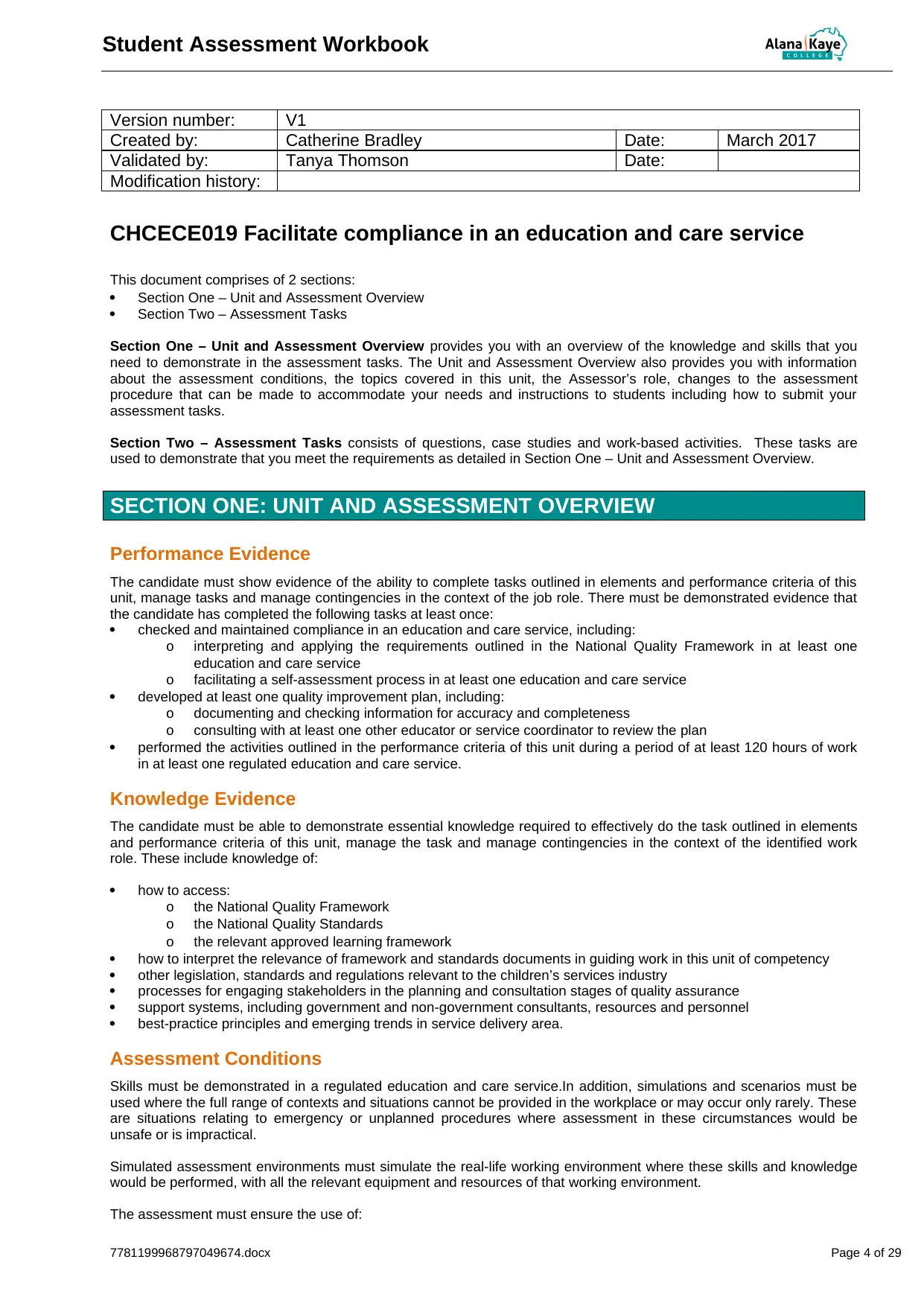
Student Assessment Workbook
Version number: V1
Created by: Catherine Bradley Date: March 2017
Validated by: Tanya Thomson Date:
Modification history:
CHCECE019 Facilitate compliance in an education and care service
This document comprises of 2 sections:
Section One – Unit and Assessment Overview
Section Two – Assessment Tasks
Section One – Unit and Assessment Overview provides you with an overview of the knowledge and skills that you
need to demonstrate in the assessment tasks. The Unit and Assessment Overview also provides you with information
about the assessment conditions, the topics covered in this unit, the Assessor’s role, changes to the assessment
procedure that can be made to accommodate your needs and instructions to students including how to submit your
assessment tasks.
Section Two – Assessment Tasks consists of questions, case studies and work-based activities. These tasks are
used to demonstrate that you meet the requirements as detailed in Section One – Unit and Assessment Overview.
SECTION ONE: UNIT AND ASSESSMENT OVERVIEW
Performance Evidence
The candidate must show evidence of the ability to complete tasks outlined in elements and performance criteria of this
unit, manage tasks and manage contingencies in the context of the job role. There must be demonstrated evidence that
the candidate has completed the following tasks at least once:
checked and maintained compliance in an education and care service, including:
o interpreting and applying the requirements outlined in the National Quality Framework in at least one
education and care service
o facilitating a self-assessment process in at least one education and care service
developed at least one quality improvement plan, including:
o documenting and checking information for accuracy and completeness
o consulting with at least one other educator or service coordinator to review the plan
performed the activities outlined in the performance criteria of this unit during a period of at least 120 hours of work
in at least one regulated education and care service.
Knowledge Evidence
The candidate must be able to demonstrate essential knowledge required to effectively do the task outlined in elements
and performance criteria of this unit, manage the task and manage contingencies in the context of the identified work
role. These include knowledge of:
how to access:
o the National Quality Framework
o the National Quality Standards
o the relevant approved learning framework
how to interpret the relevance of framework and standards documents in guiding work in this unit of competency
other legislation, standards and regulations relevant to the children’s services industry
processes for engaging stakeholders in the planning and consultation stages of quality assurance
support systems, including government and non-government consultants, resources and personnel
best-practice principles and emerging trends in service delivery area.
Assessment Conditions
Skills must be demonstrated in a regulated education and care service.In addition, simulations and scenarios must be
used where the full range of contexts and situations cannot be provided in the workplace or may occur only rarely. These
are situations relating to emergency or unplanned procedures where assessment in these circumstances would be
unsafe or is impractical.
Simulated assessment environments must simulate the real-life working environment where these skills and knowledge
would be performed, with all the relevant equipment and resources of that working environment.
The assessment must ensure the use of:
7781199968797049674.docx Page 4 of 29
Version number: V1
Created by: Catherine Bradley Date: March 2017
Validated by: Tanya Thomson Date:
Modification history:
CHCECE019 Facilitate compliance in an education and care service
This document comprises of 2 sections:
Section One – Unit and Assessment Overview
Section Two – Assessment Tasks
Section One – Unit and Assessment Overview provides you with an overview of the knowledge and skills that you
need to demonstrate in the assessment tasks. The Unit and Assessment Overview also provides you with information
about the assessment conditions, the topics covered in this unit, the Assessor’s role, changes to the assessment
procedure that can be made to accommodate your needs and instructions to students including how to submit your
assessment tasks.
Section Two – Assessment Tasks consists of questions, case studies and work-based activities. These tasks are
used to demonstrate that you meet the requirements as detailed in Section One – Unit and Assessment Overview.
SECTION ONE: UNIT AND ASSESSMENT OVERVIEW
Performance Evidence
The candidate must show evidence of the ability to complete tasks outlined in elements and performance criteria of this
unit, manage tasks and manage contingencies in the context of the job role. There must be demonstrated evidence that
the candidate has completed the following tasks at least once:
checked and maintained compliance in an education and care service, including:
o interpreting and applying the requirements outlined in the National Quality Framework in at least one
education and care service
o facilitating a self-assessment process in at least one education and care service
developed at least one quality improvement plan, including:
o documenting and checking information for accuracy and completeness
o consulting with at least one other educator or service coordinator to review the plan
performed the activities outlined in the performance criteria of this unit during a period of at least 120 hours of work
in at least one regulated education and care service.
Knowledge Evidence
The candidate must be able to demonstrate essential knowledge required to effectively do the task outlined in elements
and performance criteria of this unit, manage the task and manage contingencies in the context of the identified work
role. These include knowledge of:
how to access:
o the National Quality Framework
o the National Quality Standards
o the relevant approved learning framework
how to interpret the relevance of framework and standards documents in guiding work in this unit of competency
other legislation, standards and regulations relevant to the children’s services industry
processes for engaging stakeholders in the planning and consultation stages of quality assurance
support systems, including government and non-government consultants, resources and personnel
best-practice principles and emerging trends in service delivery area.
Assessment Conditions
Skills must be demonstrated in a regulated education and care service.In addition, simulations and scenarios must be
used where the full range of contexts and situations cannot be provided in the workplace or may occur only rarely. These
are situations relating to emergency or unplanned procedures where assessment in these circumstances would be
unsafe or is impractical.
Simulated assessment environments must simulate the real-life working environment where these skills and knowledge
would be performed, with all the relevant equipment and resources of that working environment.
The assessment must ensure the use of:
7781199968797049674.docx Page 4 of 29
Secure Best Marks with AI Grader
Need help grading? Try our AI Grader for instant feedback on your assignments.
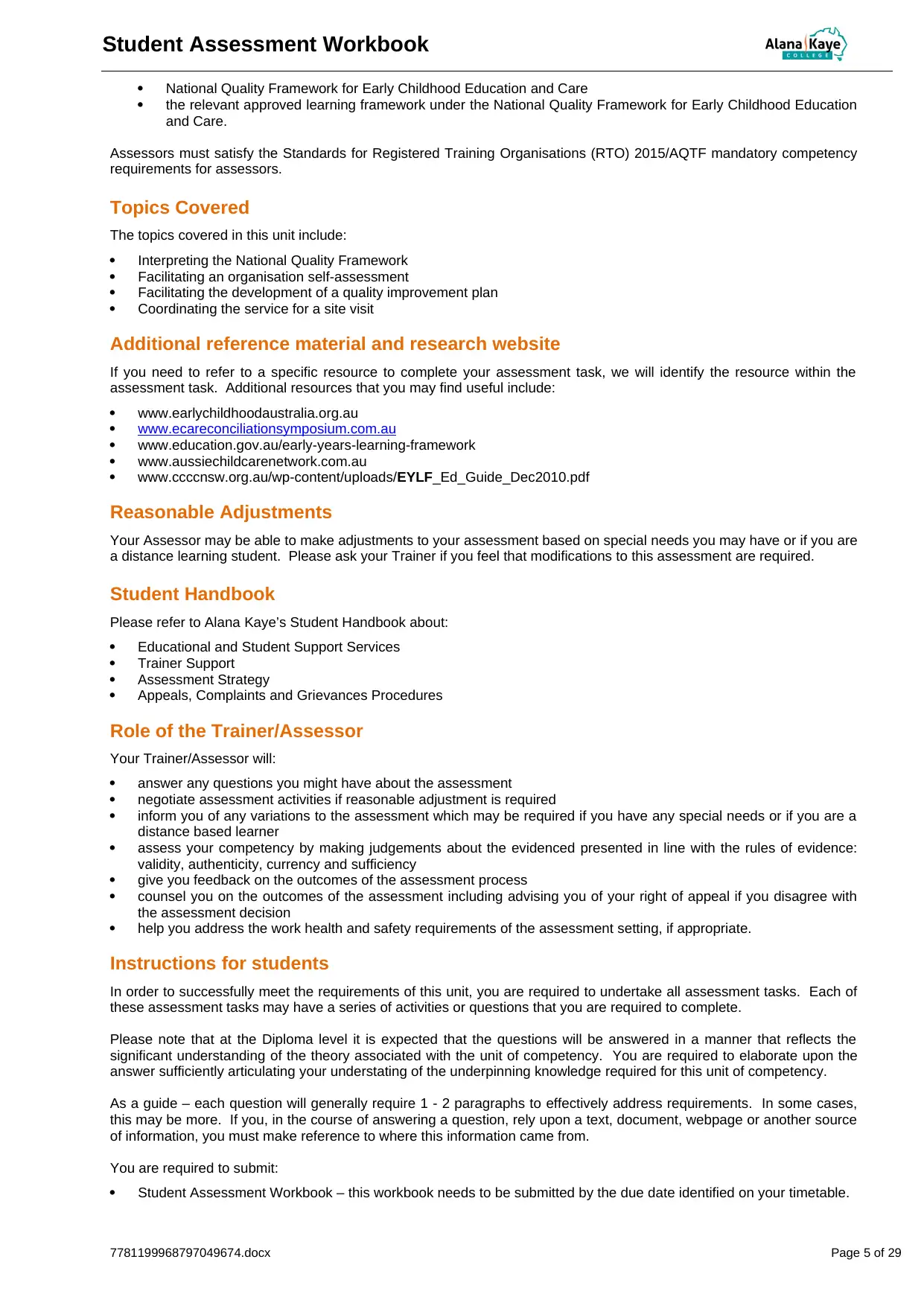
Student Assessment Workbook
National Quality Framework for Early Childhood Education and Care
the relevant approved learning framework under the National Quality Framework for Early Childhood Education
and Care.
Assessors must satisfy the Standards for Registered Training Organisations (RTO) 2015/AQTF mandatory competency
requirements for assessors.
Topics Covered
The topics covered in this unit include:
Interpreting the National Quality Framework
Facilitating an organisation self-assessment
Facilitating the development of a quality improvement plan
Coordinating the service for a site visit
Additional reference material and research website
If you need to refer to a specific resource to complete your assessment task, we will identify the resource within the
assessment task. Additional resources that you may find useful include:
www.earlychildhoodaustralia.org.au
www.ecareconciliationsymposium.com.au
www.education.gov.au/early-years-learning-framework
www.aussiechildcarenetwork.com.au
www.ccccnsw.org.au/wp-content/uploads/EYLF_Ed_Guide_Dec2010.pdf
Reasonable Adjustments
Your Assessor may be able to make adjustments to your assessment based on special needs you may have or if you are
a distance learning student. Please ask your Trainer if you feel that modifications to this assessment are required.
Student Handbook
Please refer to Alana Kaye’s Student Handbook about:
Educational and Student Support Services
Trainer Support
Assessment Strategy
Appeals, Complaints and Grievances Procedures
Role of the Trainer/Assessor
Your Trainer/Assessor will:
answer any questions you might have about the assessment
negotiate assessment activities if reasonable adjustment is required
inform you of any variations to the assessment which may be required if you have any special needs or if you are a
distance based learner
assess your competency by making judgements about the evidenced presented in line with the rules of evidence:
validity, authenticity, currency and sufficiency
give you feedback on the outcomes of the assessment process
counsel you on the outcomes of the assessment including advising you of your right of appeal if you disagree with
the assessment decision
help you address the work health and safety requirements of the assessment setting, if appropriate.
Instructions for students
In order to successfully meet the requirements of this unit, you are required to undertake all assessment tasks. Each of
these assessment tasks may have a series of activities or questions that you are required to complete.
Please note that at the Diploma level it is expected that the questions will be answered in a manner that reflects the
significant understanding of the theory associated with the unit of competency. You are required to elaborate upon the
answer sufficiently articulating your understating of the underpinning knowledge required for this unit of competency.
As a guide – each question will generally require 1 - 2 paragraphs to effectively address requirements. In some cases,
this may be more. If you, in the course of answering a question, rely upon a text, document, webpage or another source
of information, you must make reference to where this information came from.
You are required to submit:
Student Assessment Workbook – this workbook needs to be submitted by the due date identified on your timetable.
7781199968797049674.docx Page 5 of 29
National Quality Framework for Early Childhood Education and Care
the relevant approved learning framework under the National Quality Framework for Early Childhood Education
and Care.
Assessors must satisfy the Standards for Registered Training Organisations (RTO) 2015/AQTF mandatory competency
requirements for assessors.
Topics Covered
The topics covered in this unit include:
Interpreting the National Quality Framework
Facilitating an organisation self-assessment
Facilitating the development of a quality improvement plan
Coordinating the service for a site visit
Additional reference material and research website
If you need to refer to a specific resource to complete your assessment task, we will identify the resource within the
assessment task. Additional resources that you may find useful include:
www.earlychildhoodaustralia.org.au
www.ecareconciliationsymposium.com.au
www.education.gov.au/early-years-learning-framework
www.aussiechildcarenetwork.com.au
www.ccccnsw.org.au/wp-content/uploads/EYLF_Ed_Guide_Dec2010.pdf
Reasonable Adjustments
Your Assessor may be able to make adjustments to your assessment based on special needs you may have or if you are
a distance learning student. Please ask your Trainer if you feel that modifications to this assessment are required.
Student Handbook
Please refer to Alana Kaye’s Student Handbook about:
Educational and Student Support Services
Trainer Support
Assessment Strategy
Appeals, Complaints and Grievances Procedures
Role of the Trainer/Assessor
Your Trainer/Assessor will:
answer any questions you might have about the assessment
negotiate assessment activities if reasonable adjustment is required
inform you of any variations to the assessment which may be required if you have any special needs or if you are a
distance based learner
assess your competency by making judgements about the evidenced presented in line with the rules of evidence:
validity, authenticity, currency and sufficiency
give you feedback on the outcomes of the assessment process
counsel you on the outcomes of the assessment including advising you of your right of appeal if you disagree with
the assessment decision
help you address the work health and safety requirements of the assessment setting, if appropriate.
Instructions for students
In order to successfully meet the requirements of this unit, you are required to undertake all assessment tasks. Each of
these assessment tasks may have a series of activities or questions that you are required to complete.
Please note that at the Diploma level it is expected that the questions will be answered in a manner that reflects the
significant understanding of the theory associated with the unit of competency. You are required to elaborate upon the
answer sufficiently articulating your understating of the underpinning knowledge required for this unit of competency.
As a guide – each question will generally require 1 - 2 paragraphs to effectively address requirements. In some cases,
this may be more. If you, in the course of answering a question, rely upon a text, document, webpage or another source
of information, you must make reference to where this information came from.
You are required to submit:
Student Assessment Workbook – this workbook needs to be submitted by the due date identified on your timetable.
7781199968797049674.docx Page 5 of 29
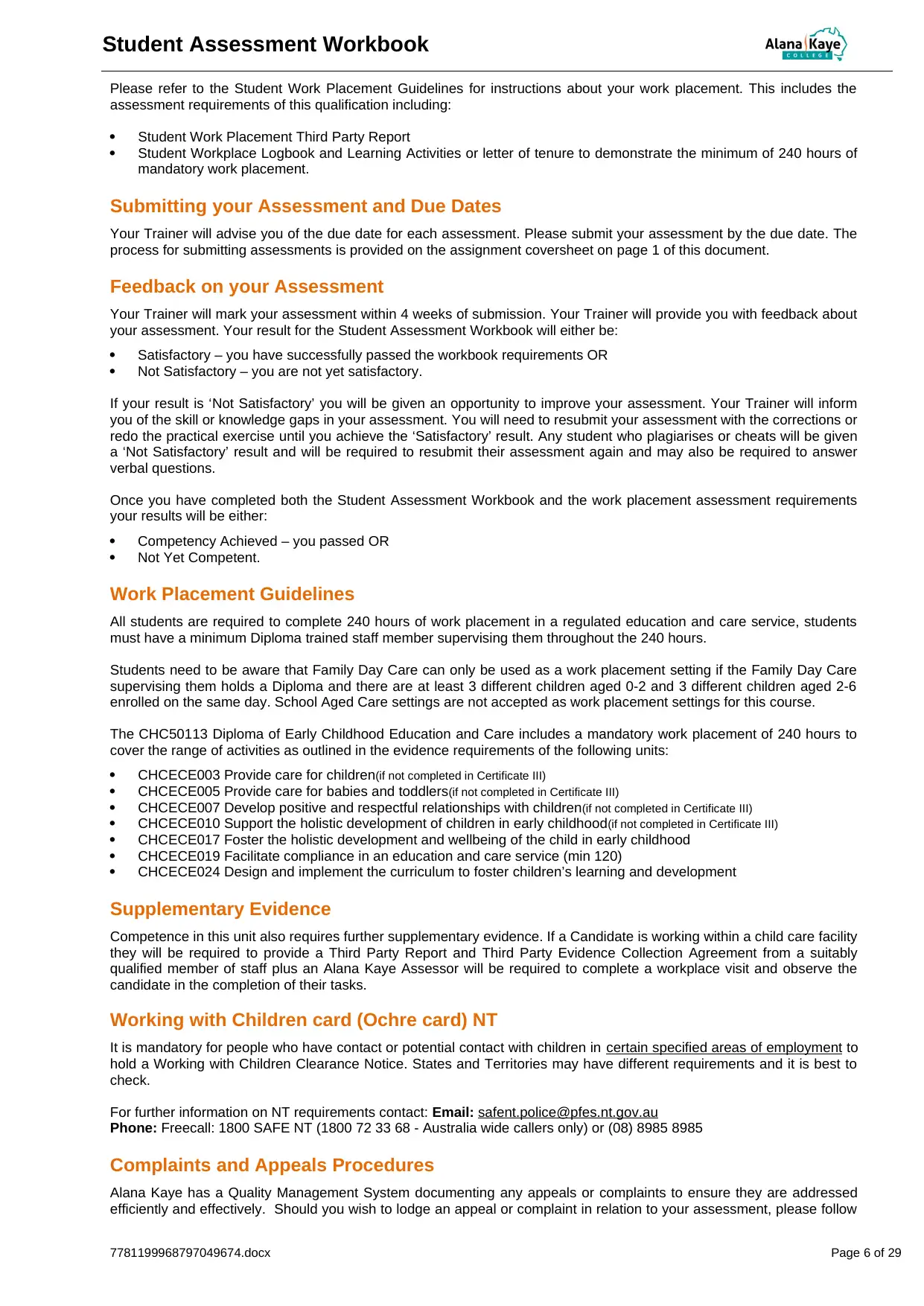
Student Assessment Workbook
Please refer to the Student Work Placement Guidelines for instructions about your work placement. This includes the
assessment requirements of this qualification including:
Student Work Placement Third Party Report
Student Workplace Logbook and Learning Activities or letter of tenure to demonstrate the minimum of 240 hours of
mandatory work placement.
Submitting your Assessment and Due Dates
Your Trainer will advise you of the due date for each assessment. Please submit your assessment by the due date. The
process for submitting assessments is provided on the assignment coversheet on page 1 of this document.
Feedback on your Assessment
Your Trainer will mark your assessment within 4 weeks of submission. Your Trainer will provide you with feedback about
your assessment. Your result for the Student Assessment Workbook will either be:
Satisfactory – you have successfully passed the workbook requirements OR
Not Satisfactory – you are not yet satisfactory.
If your result is ‘Not Satisfactory’ you will be given an opportunity to improve your assessment. Your Trainer will inform
you of the skill or knowledge gaps in your assessment. You will need to resubmit your assessment with the corrections or
redo the practical exercise until you achieve the ‘Satisfactory’ result. Any student who plagiarises or cheats will be given
a ‘Not Satisfactory’ result and will be required to resubmit their assessment again and may also be required to answer
verbal questions.
Once you have completed both the Student Assessment Workbook and the work placement assessment requirements
your results will be either:
Competency Achieved – you passed OR
Not Yet Competent.
Work Placement Guidelines
All students are required to complete 240 hours of work placement in a regulated education and care service, students
must have a minimum Diploma trained staff member supervising them throughout the 240 hours.
Students need to be aware that Family Day Care can only be used as a work placement setting if the Family Day Care
supervising them holds a Diploma and there are at least 3 different children aged 0-2 and 3 different children aged 2-6
enrolled on the same day. School Aged Care settings are not accepted as work placement settings for this course.
The CHC50113 Diploma of Early Childhood Education and Care includes a mandatory work placement of 240 hours to
cover the range of activities as outlined in the evidence requirements of the following units:
CHCECE003 Provide care for children(if not completed in Certificate III)
CHCECE005 Provide care for babies and toddlers(if not completed in Certificate III)
CHCECE007 Develop positive and respectful relationships with children(if not completed in Certificate III)
CHCECE010 Support the holistic development of children in early childhood(if not completed in Certificate III)
CHCECE017 Foster the holistic development and wellbeing of the child in early childhood
CHCECE019 Facilitate compliance in an education and care service (min 120)
CHCECE024 Design and implement the curriculum to foster children’s learning and development
Supplementary Evidence
Competence in this unit also requires further supplementary evidence. If a Candidate is working within a child care facility
they will be required to provide a Third Party Report and Third Party Evidence Collection Agreement from a suitably
qualified member of staff plus an Alana Kaye Assessor will be required to complete a workplace visit and observe the
candidate in the completion of their tasks.
Working with Children card (Ochre card) NT
It is mandatory for people who have contact or potential contact with children in certain specified areas of employment to
hold a Working with Children Clearance Notice. States and Territories may have different requirements and it is best to
check.
For further information on NT requirements contact: Email: safent.police@pfes.nt.gov.au
Phone: Freecall: 1800 SAFE NT (1800 72 33 68 - Australia wide callers only) or (08) 8985 8985
Complaints and Appeals Procedures
Alana Kaye has a Quality Management System documenting any appeals or complaints to ensure they are addressed
efficiently and effectively. Should you wish to lodge an appeal or complaint in relation to your assessment, please follow
7781199968797049674.docx Page 6 of 29
Please refer to the Student Work Placement Guidelines for instructions about your work placement. This includes the
assessment requirements of this qualification including:
Student Work Placement Third Party Report
Student Workplace Logbook and Learning Activities or letter of tenure to demonstrate the minimum of 240 hours of
mandatory work placement.
Submitting your Assessment and Due Dates
Your Trainer will advise you of the due date for each assessment. Please submit your assessment by the due date. The
process for submitting assessments is provided on the assignment coversheet on page 1 of this document.
Feedback on your Assessment
Your Trainer will mark your assessment within 4 weeks of submission. Your Trainer will provide you with feedback about
your assessment. Your result for the Student Assessment Workbook will either be:
Satisfactory – you have successfully passed the workbook requirements OR
Not Satisfactory – you are not yet satisfactory.
If your result is ‘Not Satisfactory’ you will be given an opportunity to improve your assessment. Your Trainer will inform
you of the skill or knowledge gaps in your assessment. You will need to resubmit your assessment with the corrections or
redo the practical exercise until you achieve the ‘Satisfactory’ result. Any student who plagiarises or cheats will be given
a ‘Not Satisfactory’ result and will be required to resubmit their assessment again and may also be required to answer
verbal questions.
Once you have completed both the Student Assessment Workbook and the work placement assessment requirements
your results will be either:
Competency Achieved – you passed OR
Not Yet Competent.
Work Placement Guidelines
All students are required to complete 240 hours of work placement in a regulated education and care service, students
must have a minimum Diploma trained staff member supervising them throughout the 240 hours.
Students need to be aware that Family Day Care can only be used as a work placement setting if the Family Day Care
supervising them holds a Diploma and there are at least 3 different children aged 0-2 and 3 different children aged 2-6
enrolled on the same day. School Aged Care settings are not accepted as work placement settings for this course.
The CHC50113 Diploma of Early Childhood Education and Care includes a mandatory work placement of 240 hours to
cover the range of activities as outlined in the evidence requirements of the following units:
CHCECE003 Provide care for children(if not completed in Certificate III)
CHCECE005 Provide care for babies and toddlers(if not completed in Certificate III)
CHCECE007 Develop positive and respectful relationships with children(if not completed in Certificate III)
CHCECE010 Support the holistic development of children in early childhood(if not completed in Certificate III)
CHCECE017 Foster the holistic development and wellbeing of the child in early childhood
CHCECE019 Facilitate compliance in an education and care service (min 120)
CHCECE024 Design and implement the curriculum to foster children’s learning and development
Supplementary Evidence
Competence in this unit also requires further supplementary evidence. If a Candidate is working within a child care facility
they will be required to provide a Third Party Report and Third Party Evidence Collection Agreement from a suitably
qualified member of staff plus an Alana Kaye Assessor will be required to complete a workplace visit and observe the
candidate in the completion of their tasks.
Working with Children card (Ochre card) NT
It is mandatory for people who have contact or potential contact with children in certain specified areas of employment to
hold a Working with Children Clearance Notice. States and Territories may have different requirements and it is best to
check.
For further information on NT requirements contact: Email: safent.police@pfes.nt.gov.au
Phone: Freecall: 1800 SAFE NT (1800 72 33 68 - Australia wide callers only) or (08) 8985 8985
Complaints and Appeals Procedures
Alana Kaye has a Quality Management System documenting any appeals or complaints to ensure they are addressed
efficiently and effectively. Should you wish to lodge an appeal or complaint in relation to your assessment, please follow
7781199968797049674.docx Page 6 of 29
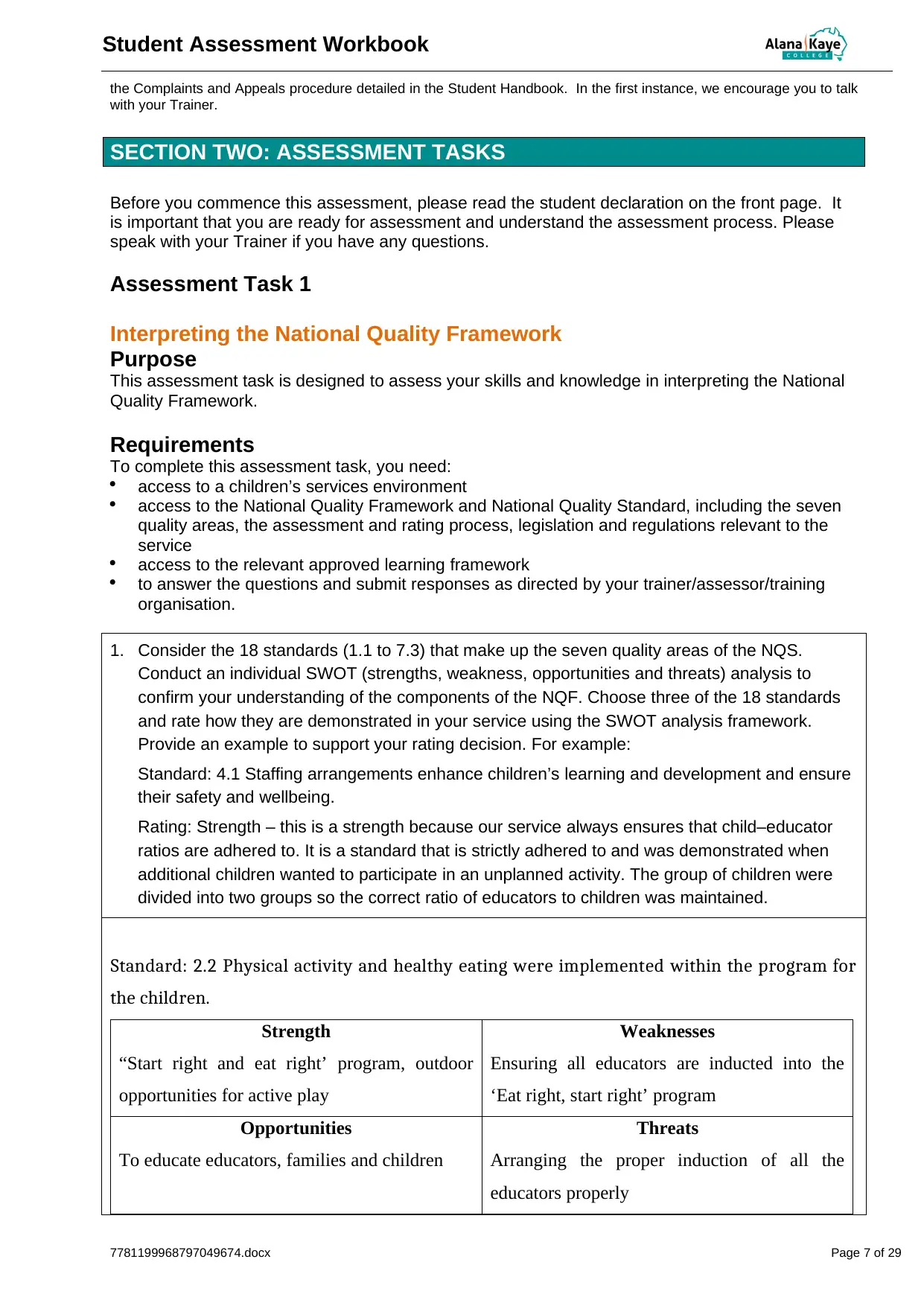
Student Assessment Workbook
the Complaints and Appeals procedure detailed in the Student Handbook. In the first instance, we encourage you to talk
with your Trainer.
SECTION TWO: ASSESSMENT TASKS
Before you commence this assessment, please read the student declaration on the front page. It
is important that you are ready for assessment and understand the assessment process. Please
speak with your Trainer if you have any questions.
Assessment Task 1
Interpreting the National Quality Framework
Purpose
This assessment task is designed to assess your skills and knowledge in interpreting the National
Quality Framework.
Requirements
To complete this assessment task, you need:
access to a children’s services environment
access to the National Quality Framework and National Quality Standard, including the seven
quality areas, the assessment and rating process, legislation and regulations relevant to the
service
access to the relevant approved learning framework
to answer the questions and submit responses as directed by your trainer/assessor/training
organisation.
1. Consider the 18 standards (1.1 to 7.3) that make up the seven quality areas of the NQS.
Conduct an individual SWOT (strengths, weakness, opportunities and threats) analysis to
confirm your understanding of the components of the NQF. Choose three of the 18 standards
and rate how they are demonstrated in your service using the SWOT analysis framework.
Provide an example to support your rating decision. For example:
Standard: 4.1 Staffing arrangements enhance children’s learning and development and ensure
their safety and wellbeing.
Rating: Strength – this is a strength because our service always ensures that child–educator
ratios are adhered to. It is a standard that is strictly adhered to and was demonstrated when
additional children wanted to participate in an unplanned activity. The group of children were
divided into two groups so the correct ratio of educators to children was maintained.
Standard: 2.2 Physical activity and healthy eating were implemented within the program for
the children.
Strength
“Start right and eat right’ program, outdoor
opportunities for active play
Weaknesses
Ensuring all educators are inducted into the
‘Eat right, start right’ program
Opportunities
To educate educators, families and children
Threats
Arranging the proper induction of all the
educators properly
7781199968797049674.docx Page 7 of 29
the Complaints and Appeals procedure detailed in the Student Handbook. In the first instance, we encourage you to talk
with your Trainer.
SECTION TWO: ASSESSMENT TASKS
Before you commence this assessment, please read the student declaration on the front page. It
is important that you are ready for assessment and understand the assessment process. Please
speak with your Trainer if you have any questions.
Assessment Task 1
Interpreting the National Quality Framework
Purpose
This assessment task is designed to assess your skills and knowledge in interpreting the National
Quality Framework.
Requirements
To complete this assessment task, you need:
access to a children’s services environment
access to the National Quality Framework and National Quality Standard, including the seven
quality areas, the assessment and rating process, legislation and regulations relevant to the
service
access to the relevant approved learning framework
to answer the questions and submit responses as directed by your trainer/assessor/training
organisation.
1. Consider the 18 standards (1.1 to 7.3) that make up the seven quality areas of the NQS.
Conduct an individual SWOT (strengths, weakness, opportunities and threats) analysis to
confirm your understanding of the components of the NQF. Choose three of the 18 standards
and rate how they are demonstrated in your service using the SWOT analysis framework.
Provide an example to support your rating decision. For example:
Standard: 4.1 Staffing arrangements enhance children’s learning and development and ensure
their safety and wellbeing.
Rating: Strength – this is a strength because our service always ensures that child–educator
ratios are adhered to. It is a standard that is strictly adhered to and was demonstrated when
additional children wanted to participate in an unplanned activity. The group of children were
divided into two groups so the correct ratio of educators to children was maintained.
Standard: 2.2 Physical activity and healthy eating were implemented within the program for
the children.
Strength
“Start right and eat right’ program, outdoor
opportunities for active play
Weaknesses
Ensuring all educators are inducted into the
‘Eat right, start right’ program
Opportunities
To educate educators, families and children
Threats
Arranging the proper induction of all the
educators properly
7781199968797049674.docx Page 7 of 29
Paraphrase This Document
Need a fresh take? Get an instant paraphrase of this document with our AI Paraphraser
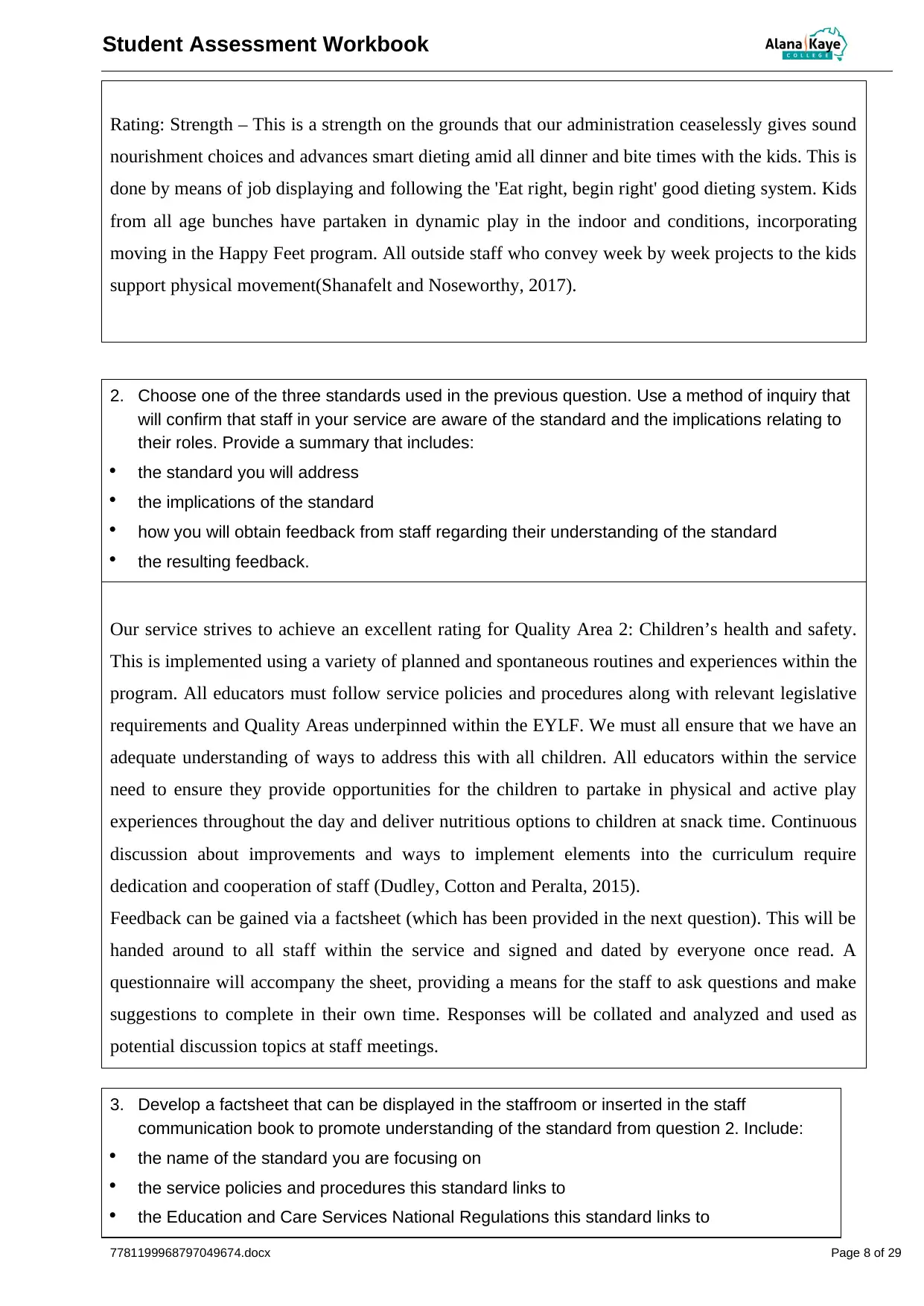
Student Assessment Workbook
Rating: Strength – This is a strength on the grounds that our administration ceaselessly gives sound
nourishment choices and advances smart dieting amid all dinner and bite times with the kids. This is
done by means of job displaying and following the 'Eat right, begin right' good dieting system. Kids
from all age bunches have partaken in dynamic play in the indoor and conditions, incorporating
moving in the Happy Feet program. All outside staff who convey week by week projects to the kids
support physical movement(Shanafelt and Noseworthy, 2017).
2. Choose one of the three standards used in the previous question. Use a method of inquiry that
will confirm that staff in your service are aware of the standard and the implications relating to
their roles. Provide a summary that includes:
the standard you will address
the implications of the standard
how you will obtain feedback from staff regarding their understanding of the standard
the resulting feedback.
Our service strives to achieve an excellent rating for Quality Area 2: Children’s health and safety.
This is implemented using a variety of planned and spontaneous routines and experiences within the
program. All educators must follow service policies and procedures along with relevant legislative
requirements and Quality Areas underpinned within the EYLF. We must all ensure that we have an
adequate understanding of ways to address this with all children. All educators within the service
need to ensure they provide opportunities for the children to partake in physical and active play
experiences throughout the day and deliver nutritious options to children at snack time. Continuous
discussion about improvements and ways to implement elements into the curriculum require
dedication and cooperation of staff (Dudley, Cotton and Peralta, 2015).
Feedback can be gained via a factsheet (which has been provided in the next question). This will be
handed around to all staff within the service and signed and dated by everyone once read. A
questionnaire will accompany the sheet, providing a means for the staff to ask questions and make
suggestions to complete in their own time. Responses will be collated and analyzed and used as
potential discussion topics at staff meetings.
3. Develop a factsheet that can be displayed in the staffroom or inserted in the staff
communication book to promote understanding of the standard from question 2. Include:
the name of the standard you are focusing on
the service policies and procedures this standard links to
the Education and Care Services National Regulations this standard links to
7781199968797049674.docx Page 8 of 29
Rating: Strength – This is a strength on the grounds that our administration ceaselessly gives sound
nourishment choices and advances smart dieting amid all dinner and bite times with the kids. This is
done by means of job displaying and following the 'Eat right, begin right' good dieting system. Kids
from all age bunches have partaken in dynamic play in the indoor and conditions, incorporating
moving in the Happy Feet program. All outside staff who convey week by week projects to the kids
support physical movement(Shanafelt and Noseworthy, 2017).
2. Choose one of the three standards used in the previous question. Use a method of inquiry that
will confirm that staff in your service are aware of the standard and the implications relating to
their roles. Provide a summary that includes:
the standard you will address
the implications of the standard
how you will obtain feedback from staff regarding their understanding of the standard
the resulting feedback.
Our service strives to achieve an excellent rating for Quality Area 2: Children’s health and safety.
This is implemented using a variety of planned and spontaneous routines and experiences within the
program. All educators must follow service policies and procedures along with relevant legislative
requirements and Quality Areas underpinned within the EYLF. We must all ensure that we have an
adequate understanding of ways to address this with all children. All educators within the service
need to ensure they provide opportunities for the children to partake in physical and active play
experiences throughout the day and deliver nutritious options to children at snack time. Continuous
discussion about improvements and ways to implement elements into the curriculum require
dedication and cooperation of staff (Dudley, Cotton and Peralta, 2015).
Feedback can be gained via a factsheet (which has been provided in the next question). This will be
handed around to all staff within the service and signed and dated by everyone once read. A
questionnaire will accompany the sheet, providing a means for the staff to ask questions and make
suggestions to complete in their own time. Responses will be collated and analyzed and used as
potential discussion topics at staff meetings.
3. Develop a factsheet that can be displayed in the staffroom or inserted in the staff
communication book to promote understanding of the standard from question 2. Include:
the name of the standard you are focusing on
the service policies and procedures this standard links to
the Education and Care Services National Regulations this standard links to
7781199968797049674.docx Page 8 of 29

Student Assessment Workbook
other legislation this standard links to (check your policies).
4. Develop a portfolio of information to help other staff understand compliance in your service.
Use a variety of materials such as fact sheets, meeting plans or a frequently asked questions
(FAQ) sheet.
The following information must be included:
An outline of the components of the NQF with an explanation of their relevance to the service
A brief explanation of ACECQA, describing who they are, what their role is and three
reasons why you may seek advice or clarification from them as the highest authority relating
to the NQF
An outline of service requirements regarding the assessment and rating process, and the
responsibilities of staff in the process
How to find out more information
Any material you do not develop yourself must include a reference stating where it was taken
from.
The National Quality Standard (NQS) is an integral part of the NQF and sets not only a
national benchmark for early youth care, and outside school hours care benefits in
Australians the NQF advances, each administration within the nation needs to be surveyed in
7781199968797049674.docx Page 9 of 29
Standard 2.2: physical activity and Healthy eating are embedded in the program
for children.
Active play policy
Relevant legislation and standards:
Education and Care Services National Law Act 2010
Education and Care Services National Regulations 2011, Regulation 168
Nutrition, food and beverages, dietary requirements
Relevant legislation:
Education and Care Services National Regulations, regulations 77,78,79,80,168
Education and Care Services National Law Act 2010
National Quality Standard 2
Australia New Zealand Food Standards Code
Food Act 1984 (Vic), as amended 2012
other legislation this standard links to (check your policies).
4. Develop a portfolio of information to help other staff understand compliance in your service.
Use a variety of materials such as fact sheets, meeting plans or a frequently asked questions
(FAQ) sheet.
The following information must be included:
An outline of the components of the NQF with an explanation of their relevance to the service
A brief explanation of ACECQA, describing who they are, what their role is and three
reasons why you may seek advice or clarification from them as the highest authority relating
to the NQF
An outline of service requirements regarding the assessment and rating process, and the
responsibilities of staff in the process
How to find out more information
Any material you do not develop yourself must include a reference stating where it was taken
from.
The National Quality Standard (NQS) is an integral part of the NQF and sets not only a
national benchmark for early youth care, and outside school hours care benefits in
Australians the NQF advances, each administration within the nation needs to be surveyed in
7781199968797049674.docx Page 9 of 29
Standard 2.2: physical activity and Healthy eating are embedded in the program
for children.
Active play policy
Relevant legislation and standards:
Education and Care Services National Law Act 2010
Education and Care Services National Regulations 2011, Regulation 168
Nutrition, food and beverages, dietary requirements
Relevant legislation:
Education and Care Services National Regulations, regulations 77,78,79,80,168
Education and Care Services National Law Act 2010
National Quality Standard 2
Australia New Zealand Food Standards Code
Food Act 1984 (Vic), as amended 2012
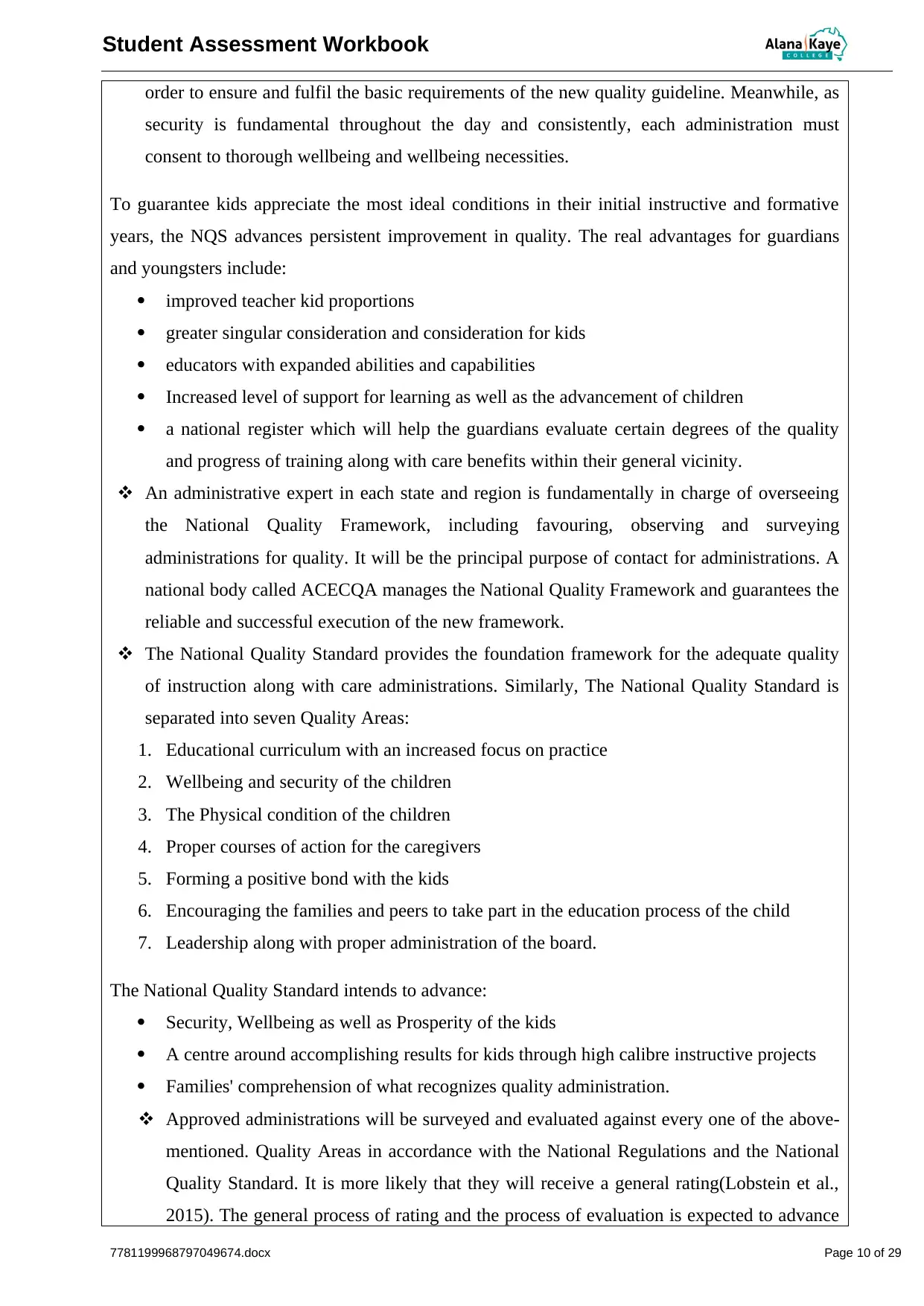
Student Assessment Workbook
order to ensure and fulfil the basic requirements of the new quality guideline. Meanwhile, as
security is fundamental throughout the day and consistently, each administration must
consent to thorough wellbeing and wellbeing necessities.
To guarantee kids appreciate the most ideal conditions in their initial instructive and formative
years, the NQS advances persistent improvement in quality. The real advantages for guardians
and youngsters include:
improved teacher kid proportions
greater singular consideration and consideration for kids
educators with expanded abilities and capabilities
Increased level of support for learning as well as the advancement of children
a national register which will help the guardians evaluate certain degrees of the quality
and progress of training along with care benefits within their general vicinity.
An administrative expert in each state and region is fundamentally in charge of overseeing
the National Quality Framework, including favouring, observing and surveying
administrations for quality. It will be the principal purpose of contact for administrations. A
national body called ACECQA manages the National Quality Framework and guarantees the
reliable and successful execution of the new framework.
The National Quality Standard provides the foundation framework for the adequate quality
of instruction along with care administrations. Similarly, The National Quality Standard is
separated into seven Quality Areas:
1. Educational curriculum with an increased focus on practice
2. Wellbeing and security of the children
3. The Physical condition of the children
4. Proper courses of action for the caregivers
5. Forming a positive bond with the kids
6. Encouraging the families and peers to take part in the education process of the child
7. Leadership along with proper administration of the board.
The National Quality Standard intends to advance:
Security, Wellbeing as well as Prosperity of the kids
A centre around accomplishing results for kids through high calibre instructive projects
Families' comprehension of what recognizes quality administration.
Approved administrations will be surveyed and evaluated against every one of the above-
mentioned. Quality Areas in accordance with the National Regulations and the National
Quality Standard. It is more likely that they will receive a general rating(Lobstein et al.,
2015). The general process of rating and the process of evaluation is expected to advance
7781199968797049674.docx Page 10 of 29
order to ensure and fulfil the basic requirements of the new quality guideline. Meanwhile, as
security is fundamental throughout the day and consistently, each administration must
consent to thorough wellbeing and wellbeing necessities.
To guarantee kids appreciate the most ideal conditions in their initial instructive and formative
years, the NQS advances persistent improvement in quality. The real advantages for guardians
and youngsters include:
improved teacher kid proportions
greater singular consideration and consideration for kids
educators with expanded abilities and capabilities
Increased level of support for learning as well as the advancement of children
a national register which will help the guardians evaluate certain degrees of the quality
and progress of training along with care benefits within their general vicinity.
An administrative expert in each state and region is fundamentally in charge of overseeing
the National Quality Framework, including favouring, observing and surveying
administrations for quality. It will be the principal purpose of contact for administrations. A
national body called ACECQA manages the National Quality Framework and guarantees the
reliable and successful execution of the new framework.
The National Quality Standard provides the foundation framework for the adequate quality
of instruction along with care administrations. Similarly, The National Quality Standard is
separated into seven Quality Areas:
1. Educational curriculum with an increased focus on practice
2. Wellbeing and security of the children
3. The Physical condition of the children
4. Proper courses of action for the caregivers
5. Forming a positive bond with the kids
6. Encouraging the families and peers to take part in the education process of the child
7. Leadership along with proper administration of the board.
The National Quality Standard intends to advance:
Security, Wellbeing as well as Prosperity of the kids
A centre around accomplishing results for kids through high calibre instructive projects
Families' comprehension of what recognizes quality administration.
Approved administrations will be surveyed and evaluated against every one of the above-
mentioned. Quality Areas in accordance with the National Regulations and the National
Quality Standard. It is more likely that they will receive a general rating(Lobstein et al.,
2015). The general process of rating and the process of evaluation is expected to advance
7781199968797049674.docx Page 10 of 29
Secure Best Marks with AI Grader
Need help grading? Try our AI Grader for instant feedback on your assignments.
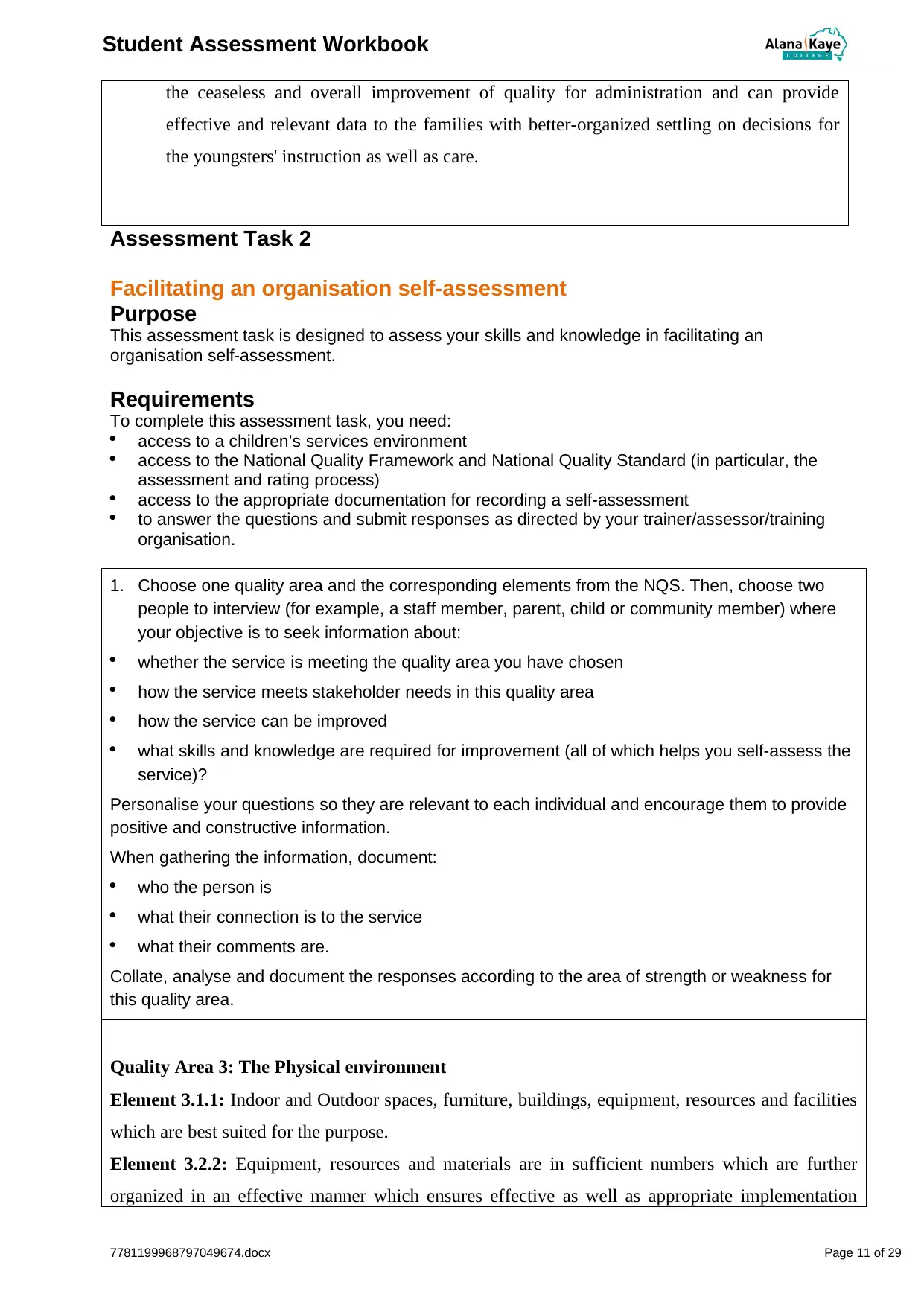
Student Assessment Workbook
the ceaseless and overall improvement of quality for administration and can provide
effective and relevant data to the families with better-organized settling on decisions for
the youngsters' instruction as well as care.
Assessment Task 2
Facilitating an organisation self-assessment
Purpose
This assessment task is designed to assess your skills and knowledge in facilitating an
organisation self-assessment.
Requirements
To complete this assessment task, you need:
access to a children’s services environment
access to the National Quality Framework and National Quality Standard (in particular, the
assessment and rating process)
access to the appropriate documentation for recording a self-assessment
to answer the questions and submit responses as directed by your trainer/assessor/training
organisation.
1. Choose one quality area and the corresponding elements from the NQS. Then, choose two
people to interview (for example, a staff member, parent, child or community member) where
your objective is to seek information about:
whether the service is meeting the quality area you have chosen
how the service meets stakeholder needs in this quality area
how the service can be improved
what skills and knowledge are required for improvement (all of which helps you self-assess the
service)?
Personalise your questions so they are relevant to each individual and encourage them to provide
positive and constructive information.
When gathering the information, document:
who the person is
what their connection is to the service
what their comments are.
Collate, analyse and document the responses according to the area of strength or weakness for
this quality area.
Quality Area 3: The Physical environment
Element 3.1.1: Indoor and Outdoor spaces, furniture, buildings, equipment, resources and facilities
which are best suited for the purpose.
Element 3.2.2: Equipment, resources and materials are in sufficient numbers which are further
organized in an effective manner which ensures effective as well as appropriate implementation
7781199968797049674.docx Page 11 of 29
the ceaseless and overall improvement of quality for administration and can provide
effective and relevant data to the families with better-organized settling on decisions for
the youngsters' instruction as well as care.
Assessment Task 2
Facilitating an organisation self-assessment
Purpose
This assessment task is designed to assess your skills and knowledge in facilitating an
organisation self-assessment.
Requirements
To complete this assessment task, you need:
access to a children’s services environment
access to the National Quality Framework and National Quality Standard (in particular, the
assessment and rating process)
access to the appropriate documentation for recording a self-assessment
to answer the questions and submit responses as directed by your trainer/assessor/training
organisation.
1. Choose one quality area and the corresponding elements from the NQS. Then, choose two
people to interview (for example, a staff member, parent, child or community member) where
your objective is to seek information about:
whether the service is meeting the quality area you have chosen
how the service meets stakeholder needs in this quality area
how the service can be improved
what skills and knowledge are required for improvement (all of which helps you self-assess the
service)?
Personalise your questions so they are relevant to each individual and encourage them to provide
positive and constructive information.
When gathering the information, document:
who the person is
what their connection is to the service
what their comments are.
Collate, analyse and document the responses according to the area of strength or weakness for
this quality area.
Quality Area 3: The Physical environment
Element 3.1.1: Indoor and Outdoor spaces, furniture, buildings, equipment, resources and facilities
which are best suited for the purpose.
Element 3.2.2: Equipment, resources and materials are in sufficient numbers which are further
organized in an effective manner which ensures effective as well as appropriate implementation
7781199968797049674.docx Page 11 of 29

Student Assessment Workbook
with the program which allows for multiple usages.
Person 1 is an educational leader who works in the nursery with children aged 0-2 years as room
leader/educator.
Comments: The service lacks multiple numbers of resources available for implementation within
the program. This shortfall makes variety, inclusion and group play opportunities difficult to
provide and implement. Due to large numbers of children within the service and other age groups
requiring the use of specific materials and resources on regular basis difficult also not enough
resources and or equipment in numbers to accommodate comfortably between all areas of the
service.
Positives: All equipment, buildings and furniture are well maintained, in good working order and
deliver appropriate function. Outdoor and indoor spaces are adequately utilised and suited to their
purpose.
Person 2 is a Parent with the child in toddler's room with Kim, mother of Kane who attends service
full-time (5 days a week 7am-4pm)
Comments: Kim noted that she was happy with the set-up and variety of resources, activities and
experiences made available to her son each time he was in care. Both the indoor and outdoor
environments displayed high level of cleanliness and aesthetics, and appear to be well-maintained.
Negatives: She has noted that many activities on offer within the environment lack multiple
numbers of resources to accommodate a large number of children. Her son often comes home and
comments that he was unable to play at a specific activity as there weren't enough blocks, toys,
paper etc. to be able to do so.
The candidate must have analyzed the feedback from the three stakeholders; for example, it is
evident that we are achieving a well-maintained and clean environment, building and surroundings,
including furniture and indoor and outdoor play spaces. Constructive criticism suggested that
resources and materials are often inadequate and too few in number, which results in children
missing out on the opportunity to take part in all the fields of interest in the program and educators
finding it difficult to plan around these to enable successful, inclusive (Peñalvo et al., 2015).
2. Prepare and present an information display that reflects the feedback summaries and the self-
assessment information you collected in Part A. The display may be a poster including
photographs, handouts or information sheet, etc. and should be suited to all stakeholders.
Include the following in your display:
Information about the quality area and element you reviewed
Results of the feedback in relation to the quality area and elements in an easy-to-read format
that is appropriate to the varied audience; the display should show results against the level of
performance required by the NQF, what the service is doing well and how it plans to improve
7781199968797049674.docx Page 12 of 29
with the program which allows for multiple usages.
Person 1 is an educational leader who works in the nursery with children aged 0-2 years as room
leader/educator.
Comments: The service lacks multiple numbers of resources available for implementation within
the program. This shortfall makes variety, inclusion and group play opportunities difficult to
provide and implement. Due to large numbers of children within the service and other age groups
requiring the use of specific materials and resources on regular basis difficult also not enough
resources and or equipment in numbers to accommodate comfortably between all areas of the
service.
Positives: All equipment, buildings and furniture are well maintained, in good working order and
deliver appropriate function. Outdoor and indoor spaces are adequately utilised and suited to their
purpose.
Person 2 is a Parent with the child in toddler's room with Kim, mother of Kane who attends service
full-time (5 days a week 7am-4pm)
Comments: Kim noted that she was happy with the set-up and variety of resources, activities and
experiences made available to her son each time he was in care. Both the indoor and outdoor
environments displayed high level of cleanliness and aesthetics, and appear to be well-maintained.
Negatives: She has noted that many activities on offer within the environment lack multiple
numbers of resources to accommodate a large number of children. Her son often comes home and
comments that he was unable to play at a specific activity as there weren't enough blocks, toys,
paper etc. to be able to do so.
The candidate must have analyzed the feedback from the three stakeholders; for example, it is
evident that we are achieving a well-maintained and clean environment, building and surroundings,
including furniture and indoor and outdoor play spaces. Constructive criticism suggested that
resources and materials are often inadequate and too few in number, which results in children
missing out on the opportunity to take part in all the fields of interest in the program and educators
finding it difficult to plan around these to enable successful, inclusive (Peñalvo et al., 2015).
2. Prepare and present an information display that reflects the feedback summaries and the self-
assessment information you collected in Part A. The display may be a poster including
photographs, handouts or information sheet, etc. and should be suited to all stakeholders.
Include the following in your display:
Information about the quality area and element you reviewed
Results of the feedback in relation to the quality area and elements in an easy-to-read format
that is appropriate to the varied audience; the display should show results against the level of
performance required by the NQF, what the service is doing well and how it plans to improve
7781199968797049674.docx Page 12 of 29
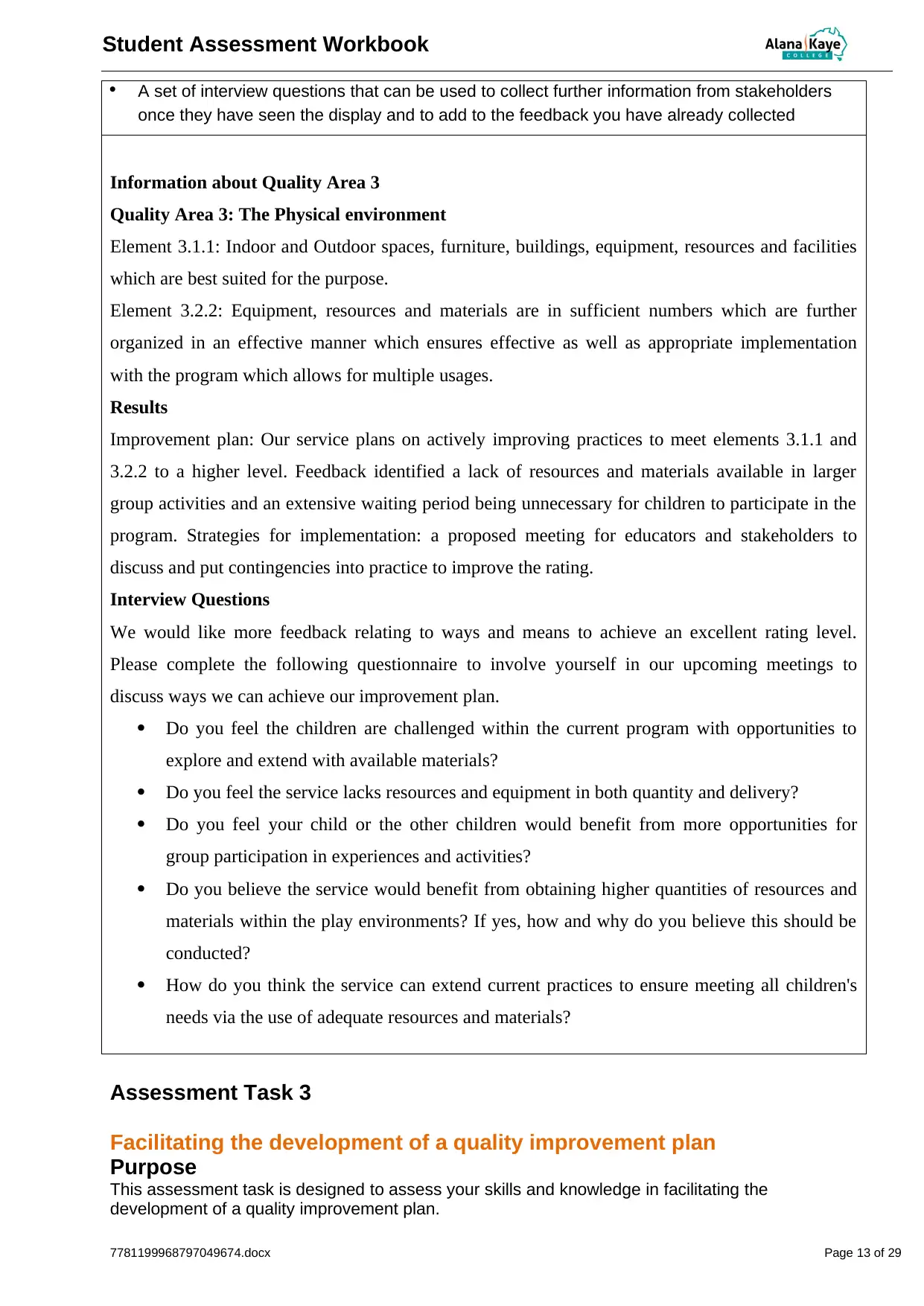
Student Assessment Workbook
A set of interview questions that can be used to collect further information from stakeholders
once they have seen the display and to add to the feedback you have already collected
Information about Quality Area 3
Quality Area 3: The Physical environment
Element 3.1.1: Indoor and Outdoor spaces, furniture, buildings, equipment, resources and facilities
which are best suited for the purpose.
Element 3.2.2: Equipment, resources and materials are in sufficient numbers which are further
organized in an effective manner which ensures effective as well as appropriate implementation
with the program which allows for multiple usages.
Results
Improvement plan: Our service plans on actively improving practices to meet elements 3.1.1 and
3.2.2 to a higher level. Feedback identified a lack of resources and materials available in larger
group activities and an extensive waiting period being unnecessary for children to participate in the
program. Strategies for implementation: a proposed meeting for educators and stakeholders to
discuss and put contingencies into practice to improve the rating.
Interview Questions
We would like more feedback relating to ways and means to achieve an excellent rating level.
Please complete the following questionnaire to involve yourself in our upcoming meetings to
discuss ways we can achieve our improvement plan.
Do you feel the children are challenged within the current program with opportunities to
explore and extend with available materials?
Do you feel the service lacks resources and equipment in both quantity and delivery?
Do you feel your child or the other children would benefit from more opportunities for
group participation in experiences and activities?
Do you believe the service would benefit from obtaining higher quantities of resources and
materials within the play environments? If yes, how and why do you believe this should be
conducted?
How do you think the service can extend current practices to ensure meeting all children's
needs via the use of adequate resources and materials?
Assessment Task 3
Facilitating the development of a quality improvement plan
Purpose
This assessment task is designed to assess your skills and knowledge in facilitating the
development of a quality improvement plan.
7781199968797049674.docx Page 13 of 29
A set of interview questions that can be used to collect further information from stakeholders
once they have seen the display and to add to the feedback you have already collected
Information about Quality Area 3
Quality Area 3: The Physical environment
Element 3.1.1: Indoor and Outdoor spaces, furniture, buildings, equipment, resources and facilities
which are best suited for the purpose.
Element 3.2.2: Equipment, resources and materials are in sufficient numbers which are further
organized in an effective manner which ensures effective as well as appropriate implementation
with the program which allows for multiple usages.
Results
Improvement plan: Our service plans on actively improving practices to meet elements 3.1.1 and
3.2.2 to a higher level. Feedback identified a lack of resources and materials available in larger
group activities and an extensive waiting period being unnecessary for children to participate in the
program. Strategies for implementation: a proposed meeting for educators and stakeholders to
discuss and put contingencies into practice to improve the rating.
Interview Questions
We would like more feedback relating to ways and means to achieve an excellent rating level.
Please complete the following questionnaire to involve yourself in our upcoming meetings to
discuss ways we can achieve our improvement plan.
Do you feel the children are challenged within the current program with opportunities to
explore and extend with available materials?
Do you feel the service lacks resources and equipment in both quantity and delivery?
Do you feel your child or the other children would benefit from more opportunities for
group participation in experiences and activities?
Do you believe the service would benefit from obtaining higher quantities of resources and
materials within the play environments? If yes, how and why do you believe this should be
conducted?
How do you think the service can extend current practices to ensure meeting all children's
needs via the use of adequate resources and materials?
Assessment Task 3
Facilitating the development of a quality improvement plan
Purpose
This assessment task is designed to assess your skills and knowledge in facilitating the
development of a quality improvement plan.
7781199968797049674.docx Page 13 of 29
Paraphrase This Document
Need a fresh take? Get an instant paraphrase of this document with our AI Paraphraser
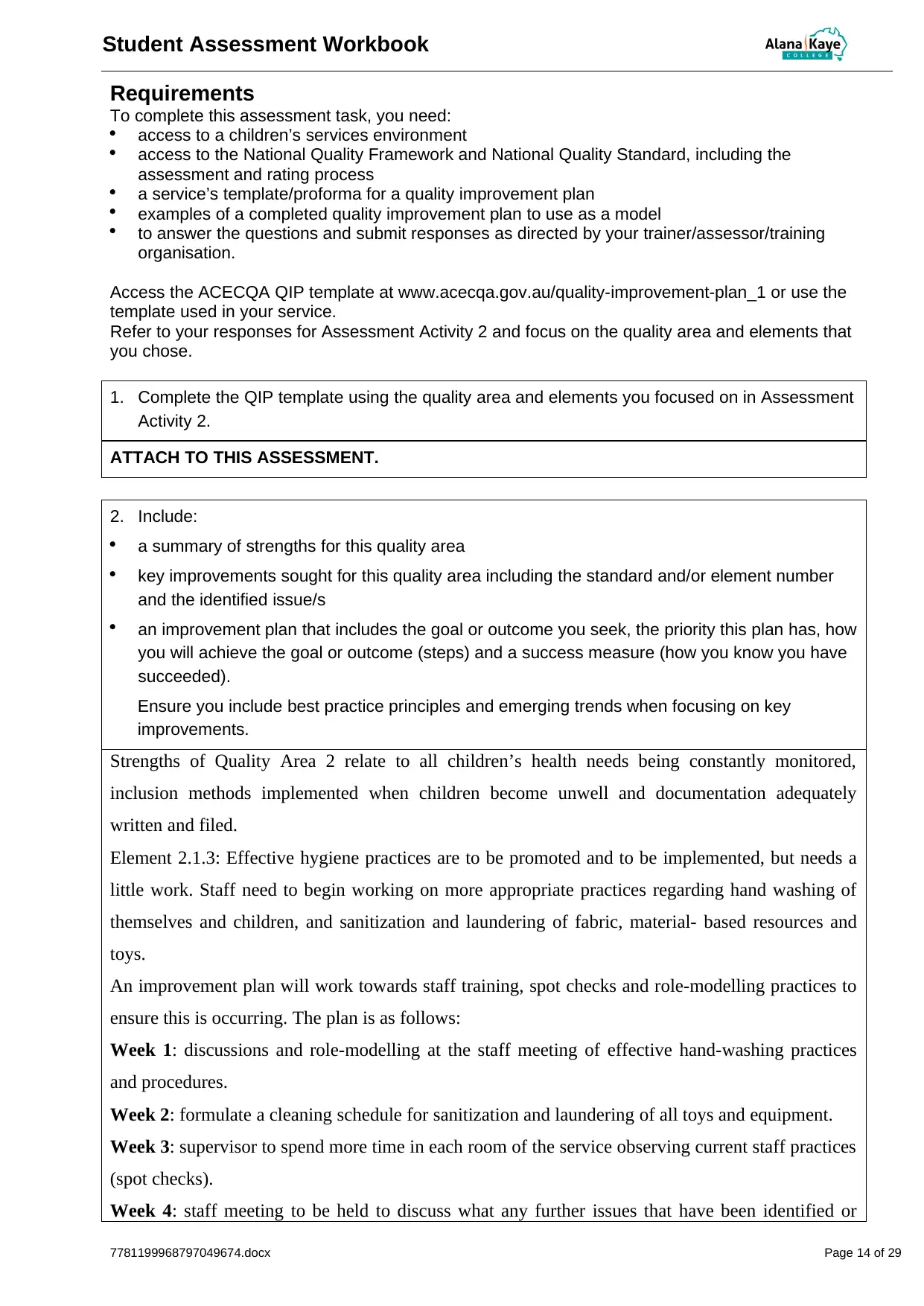
Student Assessment Workbook
Requirements
To complete this assessment task, you need:
access to a children’s services environment
access to the National Quality Framework and National Quality Standard, including the
assessment and rating process
a service’s template/proforma for a quality improvement plan
examples of a completed quality improvement plan to use as a model
to answer the questions and submit responses as directed by your trainer/assessor/training
organisation.
Access the ACECQA QIP template at www.acecqa.gov.au/quality-improvement-plan_1 or use the
template used in your service.
Refer to your responses for Assessment Activity 2 and focus on the quality area and elements that
you chose.
1. Complete the QIP template using the quality area and elements you focused on in Assessment
Activity 2.
ATTACH TO THIS ASSESSMENT.
2. Include:
a summary of strengths for this quality area
key improvements sought for this quality area including the standard and/or element number
and the identified issue/s
an improvement plan that includes the goal or outcome you seek, the priority this plan has, how
you will achieve the goal or outcome (steps) and a success measure (how you know you have
succeeded).
Ensure you include best practice principles and emerging trends when focusing on key
improvements.
Strengths of Quality Area 2 relate to all children’s health needs being constantly monitored,
inclusion methods implemented when children become unwell and documentation adequately
written and filed.
Element 2.1.3: Effective hygiene practices are to be promoted and to be implemented, but needs a
little work. Staff need to begin working on more appropriate practices regarding hand washing of
themselves and children, and sanitization and laundering of fabric, material- based resources and
toys.
An improvement plan will work towards staff training, spot checks and role-modelling practices to
ensure this is occurring. The plan is as follows:
Week 1: discussions and role-modelling at the staff meeting of effective hand-washing practices
and procedures.
Week 2: formulate a cleaning schedule for sanitization and laundering of all toys and equipment.
Week 3: supervisor to spend more time in each room of the service observing current staff practices
(spot checks).
Week 4: staff meeting to be held to discuss what any further issues that have been identified or
7781199968797049674.docx Page 14 of 29
Requirements
To complete this assessment task, you need:
access to a children’s services environment
access to the National Quality Framework and National Quality Standard, including the
assessment and rating process
a service’s template/proforma for a quality improvement plan
examples of a completed quality improvement plan to use as a model
to answer the questions and submit responses as directed by your trainer/assessor/training
organisation.
Access the ACECQA QIP template at www.acecqa.gov.au/quality-improvement-plan_1 or use the
template used in your service.
Refer to your responses for Assessment Activity 2 and focus on the quality area and elements that
you chose.
1. Complete the QIP template using the quality area and elements you focused on in Assessment
Activity 2.
ATTACH TO THIS ASSESSMENT.
2. Include:
a summary of strengths for this quality area
key improvements sought for this quality area including the standard and/or element number
and the identified issue/s
an improvement plan that includes the goal or outcome you seek, the priority this plan has, how
you will achieve the goal or outcome (steps) and a success measure (how you know you have
succeeded).
Ensure you include best practice principles and emerging trends when focusing on key
improvements.
Strengths of Quality Area 2 relate to all children’s health needs being constantly monitored,
inclusion methods implemented when children become unwell and documentation adequately
written and filed.
Element 2.1.3: Effective hygiene practices are to be promoted and to be implemented, but needs a
little work. Staff need to begin working on more appropriate practices regarding hand washing of
themselves and children, and sanitization and laundering of fabric, material- based resources and
toys.
An improvement plan will work towards staff training, spot checks and role-modelling practices to
ensure this is occurring. The plan is as follows:
Week 1: discussions and role-modelling at the staff meeting of effective hand-washing practices
and procedures.
Week 2: formulate a cleaning schedule for sanitization and laundering of all toys and equipment.
Week 3: supervisor to spend more time in each room of the service observing current staff practices
(spot checks).
Week 4: staff meeting to be held to discuss what any further issues that have been identified or
7781199968797049674.docx Page 14 of 29
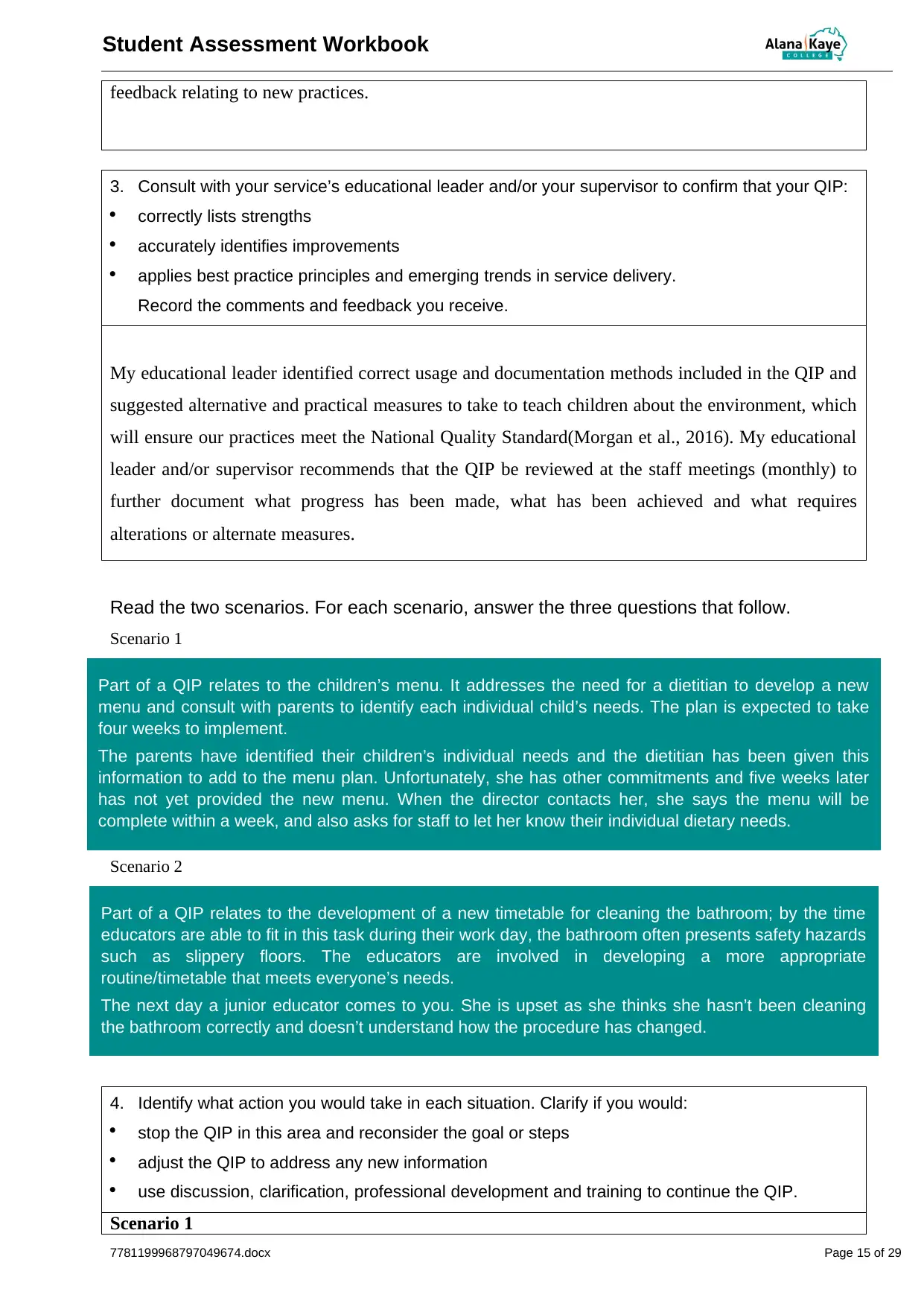
Student Assessment Workbook
feedback relating to new practices.
3. Consult with your service’s educational leader and/or your supervisor to confirm that your QIP:
correctly lists strengths
accurately identifies improvements
applies best practice principles and emerging trends in service delivery.
Record the comments and feedback you receive.
My educational leader identified correct usage and documentation methods included in the QIP and
suggested alternative and practical measures to take to teach children about the environment, which
will ensure our practices meet the National Quality Standard(Morgan et al., 2016). My educational
leader and/or supervisor recommends that the QIP be reviewed at the staff meetings (monthly) to
further document what progress has been made, what has been achieved and what requires
alterations or alternate measures.
Read the two scenarios. For each scenario, answer the three questions that follow.
Scenario 1
Part of a QIP relates to the children’s menu. It addresses the need for a dietitian to develop a new
menu and consult with parents to identify each individual child’s needs. The plan is expected to take
four weeks to implement.
The parents have identified their children’s individual needs and the dietitian has been given this
information to add to the menu plan. Unfortunately, she has other commitments and five weeks later
has not yet provided the new menu. When the director contacts her, she says the menu will be
complete within a week, and also asks for staff to let her know their individual dietary needs.
Scenario 2
Part of a QIP relates to the development of a new timetable for cleaning the bathroom; by the time
educators are able to fit in this task during their work day, the bathroom often presents safety hazards
such as slippery floors. The educators are involved in developing a more appropriate
routine/timetable that meets everyone’s needs.
The next day a junior educator comes to you. She is upset as she thinks she hasn’t been cleaning
the bathroom correctly and doesn’t understand how the procedure has changed.
4. Identify what action you would take in each situation. Clarify if you would:
stop the QIP in this area and reconsider the goal or steps
adjust the QIP to address any new information
use discussion, clarification, professional development and training to continue the QIP.
Scenario 1
7781199968797049674.docx Page 15 of 29
feedback relating to new practices.
3. Consult with your service’s educational leader and/or your supervisor to confirm that your QIP:
correctly lists strengths
accurately identifies improvements
applies best practice principles and emerging trends in service delivery.
Record the comments and feedback you receive.
My educational leader identified correct usage and documentation methods included in the QIP and
suggested alternative and practical measures to take to teach children about the environment, which
will ensure our practices meet the National Quality Standard(Morgan et al., 2016). My educational
leader and/or supervisor recommends that the QIP be reviewed at the staff meetings (monthly) to
further document what progress has been made, what has been achieved and what requires
alterations or alternate measures.
Read the two scenarios. For each scenario, answer the three questions that follow.
Scenario 1
Part of a QIP relates to the children’s menu. It addresses the need for a dietitian to develop a new
menu and consult with parents to identify each individual child’s needs. The plan is expected to take
four weeks to implement.
The parents have identified their children’s individual needs and the dietitian has been given this
information to add to the menu plan. Unfortunately, she has other commitments and five weeks later
has not yet provided the new menu. When the director contacts her, she says the menu will be
complete within a week, and also asks for staff to let her know their individual dietary needs.
Scenario 2
Part of a QIP relates to the development of a new timetable for cleaning the bathroom; by the time
educators are able to fit in this task during their work day, the bathroom often presents safety hazards
such as slippery floors. The educators are involved in developing a more appropriate
routine/timetable that meets everyone’s needs.
The next day a junior educator comes to you. She is upset as she thinks she hasn’t been cleaning
the bathroom correctly and doesn’t understand how the procedure has changed.
4. Identify what action you would take in each situation. Clarify if you would:
stop the QIP in this area and reconsider the goal or steps
adjust the QIP to address any new information
use discussion, clarification, professional development and training to continue the QIP.
Scenario 1
7781199968797049674.docx Page 15 of 29
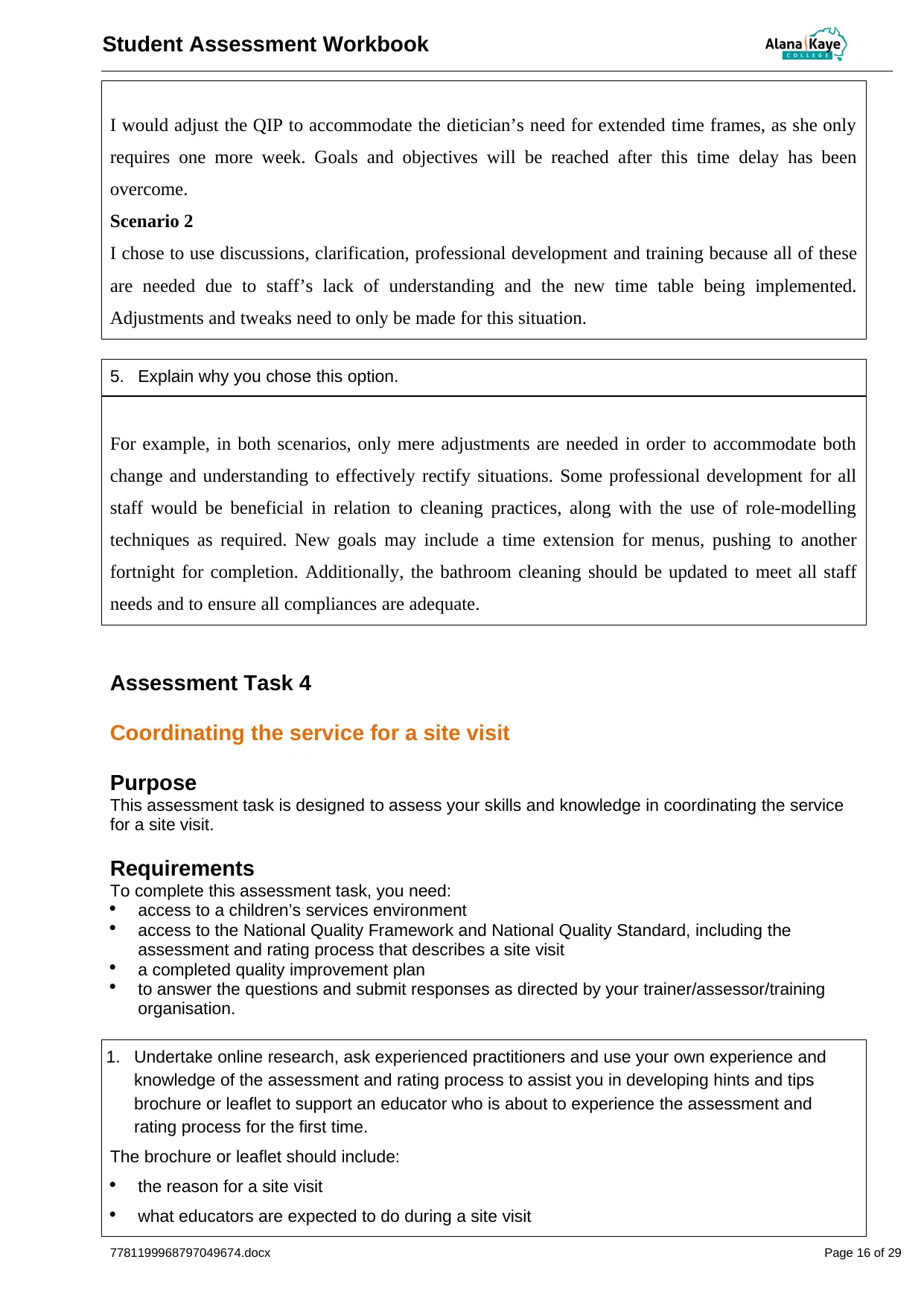
Student Assessment Workbook
I would adjust the QIP to accommodate the dietician’s need for extended time frames, as she only
requires one more week. Goals and objectives will be reached after this time delay has been
overcome.
Scenario 2
I chose to use discussions, clarification, professional development and training because all of these
are needed due to staff’s lack of understanding and the new time table being implemented.
Adjustments and tweaks need to only be made for this situation.
5. Explain why you chose this option.
For example, in both scenarios, only mere adjustments are needed in order to accommodate both
change and understanding to effectively rectify situations. Some professional development for all
staff would be beneficial in relation to cleaning practices, along with the use of role-modelling
techniques as required. New goals may include a time extension for menus, pushing to another
fortnight for completion. Additionally, the bathroom cleaning should be updated to meet all staff
needs and to ensure all compliances are adequate.
Assessment Task 4
Coordinating the service for a site visit
Purpose
This assessment task is designed to assess your skills and knowledge in coordinating the service
for a site visit.
Requirements
To complete this assessment task, you need:
access to a children’s services environment
access to the National Quality Framework and National Quality Standard, including the
assessment and rating process that describes a site visit
a completed quality improvement plan
to answer the questions and submit responses as directed by your trainer/assessor/training
organisation.
1. Undertake online research, ask experienced practitioners and use your own experience and
knowledge of the assessment and rating process to assist you in developing hints and tips
brochure or leaflet to support an educator who is about to experience the assessment and
rating process for the first time.
The brochure or leaflet should include:
the reason for a site visit
what educators are expected to do during a site visit
7781199968797049674.docx Page 16 of 29
I would adjust the QIP to accommodate the dietician’s need for extended time frames, as she only
requires one more week. Goals and objectives will be reached after this time delay has been
overcome.
Scenario 2
I chose to use discussions, clarification, professional development and training because all of these
are needed due to staff’s lack of understanding and the new time table being implemented.
Adjustments and tweaks need to only be made for this situation.
5. Explain why you chose this option.
For example, in both scenarios, only mere adjustments are needed in order to accommodate both
change and understanding to effectively rectify situations. Some professional development for all
staff would be beneficial in relation to cleaning practices, along with the use of role-modelling
techniques as required. New goals may include a time extension for menus, pushing to another
fortnight for completion. Additionally, the bathroom cleaning should be updated to meet all staff
needs and to ensure all compliances are adequate.
Assessment Task 4
Coordinating the service for a site visit
Purpose
This assessment task is designed to assess your skills and knowledge in coordinating the service
for a site visit.
Requirements
To complete this assessment task, you need:
access to a children’s services environment
access to the National Quality Framework and National Quality Standard, including the
assessment and rating process that describes a site visit
a completed quality improvement plan
to answer the questions and submit responses as directed by your trainer/assessor/training
organisation.
1. Undertake online research, ask experienced practitioners and use your own experience and
knowledge of the assessment and rating process to assist you in developing hints and tips
brochure or leaflet to support an educator who is about to experience the assessment and
rating process for the first time.
The brochure or leaflet should include:
the reason for a site visit
what educators are expected to do during a site visit
7781199968797049674.docx Page 16 of 29
Secure Best Marks with AI Grader
Need help grading? Try our AI Grader for instant feedback on your assignments.
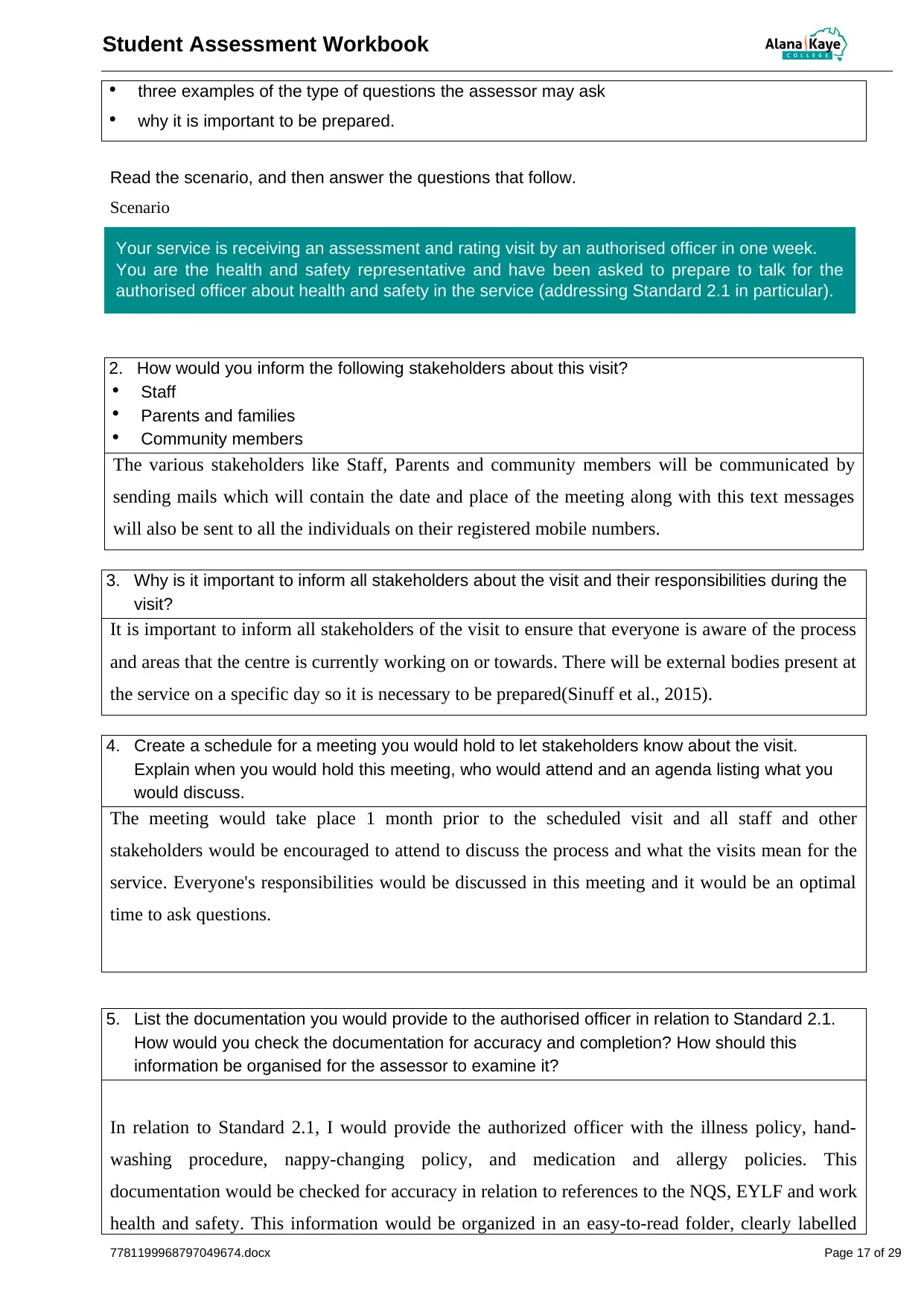
Student Assessment Workbook
three examples of the type of questions the assessor may ask
why it is important to be prepared.
Read the scenario, and then answer the questions that follow.
Scenario
Your service is receiving an assessment and rating visit by an authorised officer in one week.
You are the health and safety representative and have been asked to prepare to talk for the
authorised officer about health and safety in the service (addressing Standard 2.1 in particular).
2. How would you inform the following stakeholders about this visit?
Staff
Parents and families
Community members
The various stakeholders like Staff, Parents and community members will be communicated by
sending mails which will contain the date and place of the meeting along with this text messages
will also be sent to all the individuals on their registered mobile numbers.
3. Why is it important to inform all stakeholders about the visit and their responsibilities during the
visit?
It is important to inform all stakeholders of the visit to ensure that everyone is aware of the process
and areas that the centre is currently working on or towards. There will be external bodies present at
the service on a specific day so it is necessary to be prepared(Sinuff et al., 2015).
4. Create a schedule for a meeting you would hold to let stakeholders know about the visit.
Explain when you would hold this meeting, who would attend and an agenda listing what you
would discuss.
The meeting would take place 1 month prior to the scheduled visit and all staff and other
stakeholders would be encouraged to attend to discuss the process and what the visits mean for the
service. Everyone's responsibilities would be discussed in this meeting and it would be an optimal
time to ask questions.
5. List the documentation you would provide to the authorised officer in relation to Standard 2.1.
How would you check the documentation for accuracy and completion? How should this
information be organised for the assessor to examine it?
In relation to Standard 2.1, I would provide the authorized officer with the illness policy, hand-
washing procedure, nappy-changing policy, and medication and allergy policies. This
documentation would be checked for accuracy in relation to references to the NQS, EYLF and work
health and safety. This information would be organized in an easy-to-read folder, clearly labelled
7781199968797049674.docx Page 17 of 29
three examples of the type of questions the assessor may ask
why it is important to be prepared.
Read the scenario, and then answer the questions that follow.
Scenario
Your service is receiving an assessment and rating visit by an authorised officer in one week.
You are the health and safety representative and have been asked to prepare to talk for the
authorised officer about health and safety in the service (addressing Standard 2.1 in particular).
2. How would you inform the following stakeholders about this visit?
Staff
Parents and families
Community members
The various stakeholders like Staff, Parents and community members will be communicated by
sending mails which will contain the date and place of the meeting along with this text messages
will also be sent to all the individuals on their registered mobile numbers.
3. Why is it important to inform all stakeholders about the visit and their responsibilities during the
visit?
It is important to inform all stakeholders of the visit to ensure that everyone is aware of the process
and areas that the centre is currently working on or towards. There will be external bodies present at
the service on a specific day so it is necessary to be prepared(Sinuff et al., 2015).
4. Create a schedule for a meeting you would hold to let stakeholders know about the visit.
Explain when you would hold this meeting, who would attend and an agenda listing what you
would discuss.
The meeting would take place 1 month prior to the scheduled visit and all staff and other
stakeholders would be encouraged to attend to discuss the process and what the visits mean for the
service. Everyone's responsibilities would be discussed in this meeting and it would be an optimal
time to ask questions.
5. List the documentation you would provide to the authorised officer in relation to Standard 2.1.
How would you check the documentation for accuracy and completion? How should this
information be organised for the assessor to examine it?
In relation to Standard 2.1, I would provide the authorized officer with the illness policy, hand-
washing procedure, nappy-changing policy, and medication and allergy policies. This
documentation would be checked for accuracy in relation to references to the NQS, EYLF and work
health and safety. This information would be organized in an easy-to-read folder, clearly labelled
7781199968797049674.docx Page 17 of 29
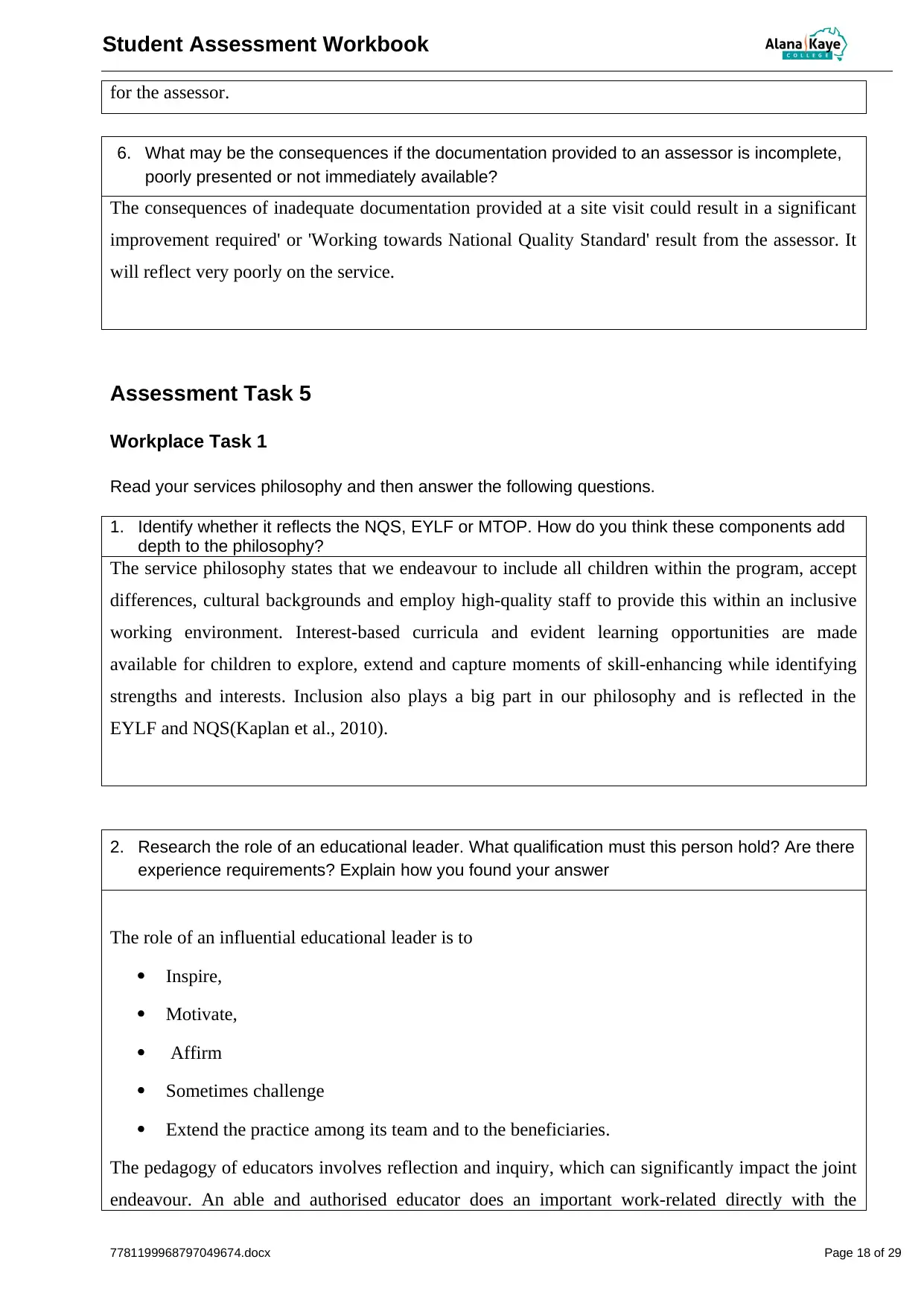
Student Assessment Workbook
for the assessor.
6. What may be the consequences if the documentation provided to an assessor is incomplete,
poorly presented or not immediately available?
The consequences of inadequate documentation provided at a site visit could result in a significant
improvement required' or 'Working towards National Quality Standard' result from the assessor. It
will reflect very poorly on the service.
Assessment Task 5
Workplace Task 1
Read your services philosophy and then answer the following questions.
1. Identify whether it reflects the NQS, EYLF or MTOP. How do you think these components add
depth to the philosophy?
The service philosophy states that we endeavour to include all children within the program, accept
differences, cultural backgrounds and employ high-quality staff to provide this within an inclusive
working environment. Interest-based curricula and evident learning opportunities are made
available for children to explore, extend and capture moments of skill-enhancing while identifying
strengths and interests. Inclusion also plays a big part in our philosophy and is reflected in the
EYLF and NQS(Kaplan et al., 2010).
2. Research the role of an educational leader. What qualification must this person hold? Are there
experience requirements? Explain how you found your answer
The role of an influential educational leader is to
Inspire,
Motivate,
Affirm
Sometimes challenge
Extend the practice among its team and to the beneficiaries.
The pedagogy of educators involves reflection and inquiry, which can significantly impact the joint
endeavour. An able and authorised educator does an important work-related directly with the
7781199968797049674.docx Page 18 of 29
for the assessor.
6. What may be the consequences if the documentation provided to an assessor is incomplete,
poorly presented or not immediately available?
The consequences of inadequate documentation provided at a site visit could result in a significant
improvement required' or 'Working towards National Quality Standard' result from the assessor. It
will reflect very poorly on the service.
Assessment Task 5
Workplace Task 1
Read your services philosophy and then answer the following questions.
1. Identify whether it reflects the NQS, EYLF or MTOP. How do you think these components add
depth to the philosophy?
The service philosophy states that we endeavour to include all children within the program, accept
differences, cultural backgrounds and employ high-quality staff to provide this within an inclusive
working environment. Interest-based curricula and evident learning opportunities are made
available for children to explore, extend and capture moments of skill-enhancing while identifying
strengths and interests. Inclusion also plays a big part in our philosophy and is reflected in the
EYLF and NQS(Kaplan et al., 2010).
2. Research the role of an educational leader. What qualification must this person hold? Are there
experience requirements? Explain how you found your answer
The role of an influential educational leader is to
Inspire,
Motivate,
Affirm
Sometimes challenge
Extend the practice among its team and to the beneficiaries.
The pedagogy of educators involves reflection and inquiry, which can significantly impact the joint
endeavour. An able and authorised educator does an important work-related directly with the
7781199968797049674.docx Page 18 of 29
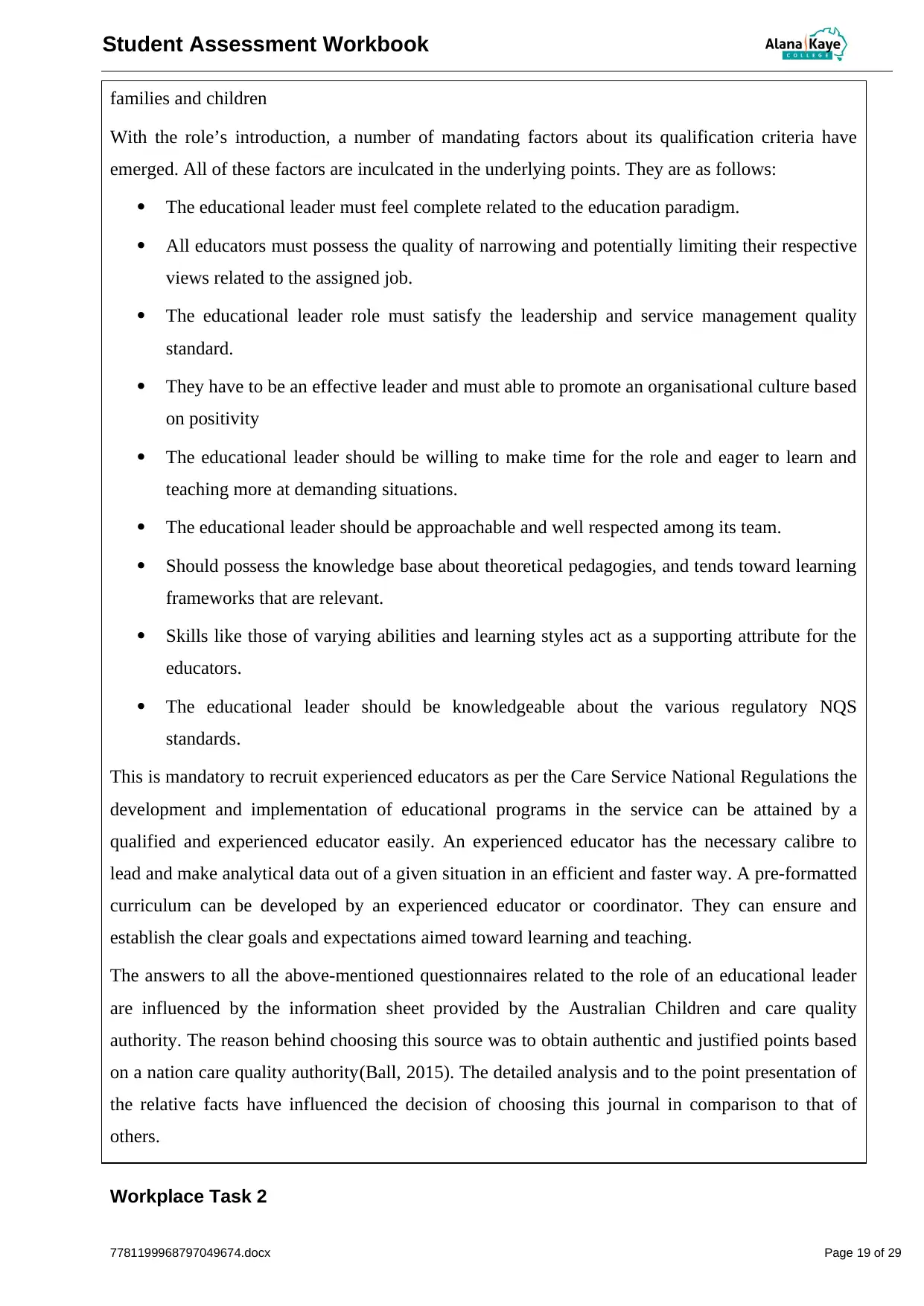
Student Assessment Workbook
families and children
With the role’s introduction, a number of mandating factors about its qualification criteria have
emerged. All of these factors are inculcated in the underlying points. They are as follows:
The educational leader must feel complete related to the education paradigm.
All educators must possess the quality of narrowing and potentially limiting their respective
views related to the assigned job.
The educational leader role must satisfy the leadership and service management quality
standard.
They have to be an effective leader and must able to promote an organisational culture based
on positivity
The educational leader should be willing to make time for the role and eager to learn and
teaching more at demanding situations.
The educational leader should be approachable and well respected among its team.
Should possess the knowledge base about theoretical pedagogies, and tends toward learning
frameworks that are relevant.
Skills like those of varying abilities and learning styles act as a supporting attribute for the
educators.
The educational leader should be knowledgeable about the various regulatory NQS
standards.
This is mandatory to recruit experienced educators as per the Care Service National Regulations the
development and implementation of educational programs in the service can be attained by a
qualified and experienced educator easily. An experienced educator has the necessary calibre to
lead and make analytical data out of a given situation in an efficient and faster way. A pre-formatted
curriculum can be developed by an experienced educator or coordinator. They can ensure and
establish the clear goals and expectations aimed toward learning and teaching.
The answers to all the above-mentioned questionnaires related to the role of an educational leader
are influenced by the information sheet provided by the Australian Children and care quality
authority. The reason behind choosing this source was to obtain authentic and justified points based
on a nation care quality authority(Ball, 2015). The detailed analysis and to the point presentation of
the relative facts have influenced the decision of choosing this journal in comparison to that of
others.
Workplace Task 2
7781199968797049674.docx Page 19 of 29
families and children
With the role’s introduction, a number of mandating factors about its qualification criteria have
emerged. All of these factors are inculcated in the underlying points. They are as follows:
The educational leader must feel complete related to the education paradigm.
All educators must possess the quality of narrowing and potentially limiting their respective
views related to the assigned job.
The educational leader role must satisfy the leadership and service management quality
standard.
They have to be an effective leader and must able to promote an organisational culture based
on positivity
The educational leader should be willing to make time for the role and eager to learn and
teaching more at demanding situations.
The educational leader should be approachable and well respected among its team.
Should possess the knowledge base about theoretical pedagogies, and tends toward learning
frameworks that are relevant.
Skills like those of varying abilities and learning styles act as a supporting attribute for the
educators.
The educational leader should be knowledgeable about the various regulatory NQS
standards.
This is mandatory to recruit experienced educators as per the Care Service National Regulations the
development and implementation of educational programs in the service can be attained by a
qualified and experienced educator easily. An experienced educator has the necessary calibre to
lead and make analytical data out of a given situation in an efficient and faster way. A pre-formatted
curriculum can be developed by an experienced educator or coordinator. They can ensure and
establish the clear goals and expectations aimed toward learning and teaching.
The answers to all the above-mentioned questionnaires related to the role of an educational leader
are influenced by the information sheet provided by the Australian Children and care quality
authority. The reason behind choosing this source was to obtain authentic and justified points based
on a nation care quality authority(Ball, 2015). The detailed analysis and to the point presentation of
the relative facts have influenced the decision of choosing this journal in comparison to that of
others.
Workplace Task 2
7781199968797049674.docx Page 19 of 29
Paraphrase This Document
Need a fresh take? Get an instant paraphrase of this document with our AI Paraphraser
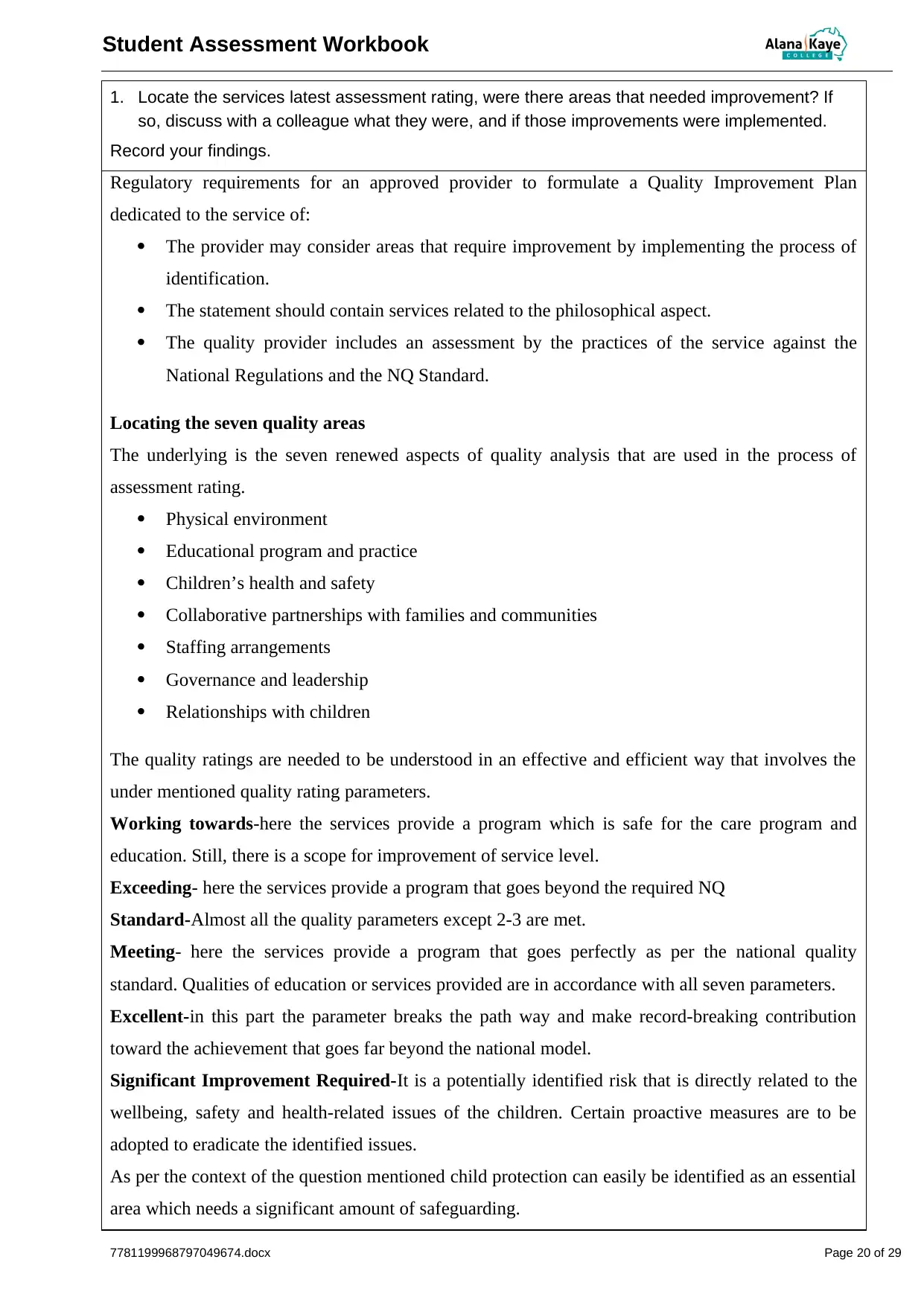
Student Assessment Workbook
1. Locate the services latest assessment rating, were there areas that needed improvement? If
so, discuss with a colleague what they were, and if those improvements were implemented.
Record your findings.
Regulatory requirements for an approved provider to formulate a Quality Improvement Plan
dedicated to the service of:
The provider may consider areas that require improvement by implementing the process of
identification.
The statement should contain services related to the philosophical aspect.
The quality provider includes an assessment by the practices of the service against the
National Regulations and the NQ Standard.
Locating the seven quality areas
The underlying is the seven renewed aspects of quality analysis that are used in the process of
assessment rating.
Physical environment
Educational program and practice
Children’s health and safety
Collaborative partnerships with families and communities
Staffing arrangements
Governance and leadership
Relationships with children
The quality ratings are needed to be understood in an effective and efficient way that involves the
under mentioned quality rating parameters.
Working towards-here the services provide a program which is safe for the care program and
education. Still, there is a scope for improvement of service level.
Exceeding- here the services provide a program that goes beyond the required NQ
Standard-Almost all the quality parameters except 2-3 are met.
Meeting- here the services provide a program that goes perfectly as per the national quality
standard. Qualities of education or services provided are in accordance with all seven parameters.
Excellent-in this part the parameter breaks the path way and make record-breaking contribution
toward the achievement that goes far beyond the national model.
Significant Improvement Required-It is a potentially identified risk that is directly related to the
wellbeing, safety and health-related issues of the children. Certain proactive measures are to be
adopted to eradicate the identified issues.
As per the context of the question mentioned child protection can easily be identified as an essential
area which needs a significant amount of safeguarding.
7781199968797049674.docx Page 20 of 29
1. Locate the services latest assessment rating, were there areas that needed improvement? If
so, discuss with a colleague what they were, and if those improvements were implemented.
Record your findings.
Regulatory requirements for an approved provider to formulate a Quality Improvement Plan
dedicated to the service of:
The provider may consider areas that require improvement by implementing the process of
identification.
The statement should contain services related to the philosophical aspect.
The quality provider includes an assessment by the practices of the service against the
National Regulations and the NQ Standard.
Locating the seven quality areas
The underlying is the seven renewed aspects of quality analysis that are used in the process of
assessment rating.
Physical environment
Educational program and practice
Children’s health and safety
Collaborative partnerships with families and communities
Staffing arrangements
Governance and leadership
Relationships with children
The quality ratings are needed to be understood in an effective and efficient way that involves the
under mentioned quality rating parameters.
Working towards-here the services provide a program which is safe for the care program and
education. Still, there is a scope for improvement of service level.
Exceeding- here the services provide a program that goes beyond the required NQ
Standard-Almost all the quality parameters except 2-3 are met.
Meeting- here the services provide a program that goes perfectly as per the national quality
standard. Qualities of education or services provided are in accordance with all seven parameters.
Excellent-in this part the parameter breaks the path way and make record-breaking contribution
toward the achievement that goes far beyond the national model.
Significant Improvement Required-It is a potentially identified risk that is directly related to the
wellbeing, safety and health-related issues of the children. Certain proactive measures are to be
adopted to eradicate the identified issues.
As per the context of the question mentioned child protection can easily be identified as an essential
area which needs a significant amount of safeguarding.
7781199968797049674.docx Page 20 of 29
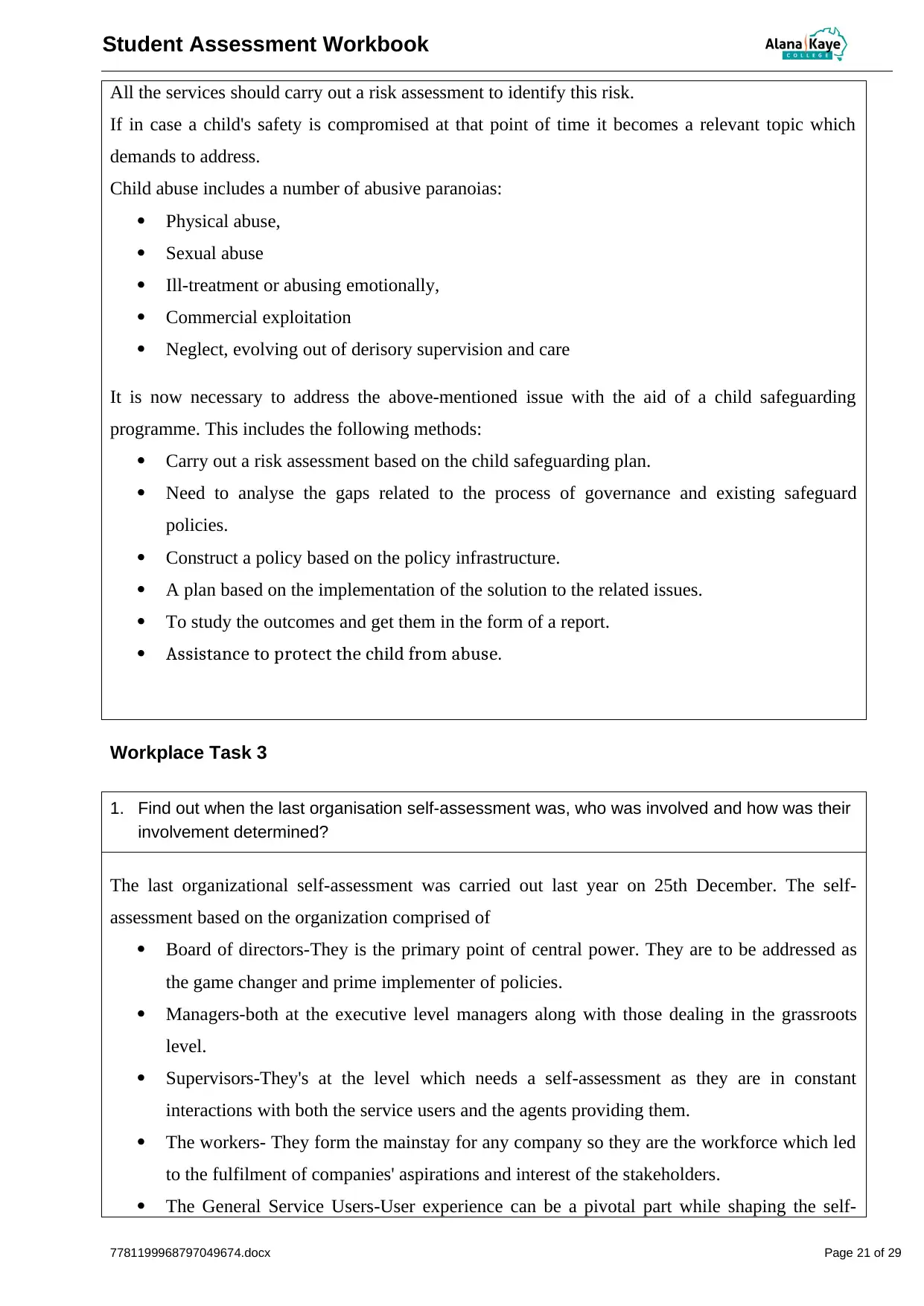
Student Assessment Workbook
All the services should carry out a risk assessment to identify this risk.
If in case a child's safety is compromised at that point of time it becomes a relevant topic which
demands to address.
Child abuse includes a number of abusive paranoias:
Physical abuse,
Sexual abuse
Ill-treatment or abusing emotionally,
Commercial exploitation
Neglect, evolving out of derisory supervision and care
It is now necessary to address the above-mentioned issue with the aid of a child safeguarding
programme. This includes the following methods:
Carry out a risk assessment based on the child safeguarding plan.
Need to analyse the gaps related to the process of governance and existing safeguard
policies.
Construct a policy based on the policy infrastructure.
A plan based on the implementation of the solution to the related issues.
To study the outcomes and get them in the form of a report.
Assistance to protect the child from abuse.
Workplace Task 3
1. Find out when the last organisation self-assessment was, who was involved and how was their
involvement determined?
The last organizational self-assessment was carried out last year on 25th December. The self-
assessment based on the organization comprised of
Board of directors-They is the primary point of central power. They are to be addressed as
the game changer and prime implementer of policies.
Managers-both at the executive level managers along with those dealing in the grassroots
level.
Supervisors-They's at the level which needs a self-assessment as they are in constant
interactions with both the service users and the agents providing them.
The workers- They form the mainstay for any company so they are the workforce which led
to the fulfilment of companies' aspirations and interest of the stakeholders.
The General Service Users-User experience can be a pivotal part while shaping the self-
7781199968797049674.docx Page 21 of 29
All the services should carry out a risk assessment to identify this risk.
If in case a child's safety is compromised at that point of time it becomes a relevant topic which
demands to address.
Child abuse includes a number of abusive paranoias:
Physical abuse,
Sexual abuse
Ill-treatment or abusing emotionally,
Commercial exploitation
Neglect, evolving out of derisory supervision and care
It is now necessary to address the above-mentioned issue with the aid of a child safeguarding
programme. This includes the following methods:
Carry out a risk assessment based on the child safeguarding plan.
Need to analyse the gaps related to the process of governance and existing safeguard
policies.
Construct a policy based on the policy infrastructure.
A plan based on the implementation of the solution to the related issues.
To study the outcomes and get them in the form of a report.
Assistance to protect the child from abuse.
Workplace Task 3
1. Find out when the last organisation self-assessment was, who was involved and how was their
involvement determined?
The last organizational self-assessment was carried out last year on 25th December. The self-
assessment based on the organization comprised of
Board of directors-They is the primary point of central power. They are to be addressed as
the game changer and prime implementer of policies.
Managers-both at the executive level managers along with those dealing in the grassroots
level.
Supervisors-They's at the level which needs a self-assessment as they are in constant
interactions with both the service users and the agents providing them.
The workers- They form the mainstay for any company so they are the workforce which led
to the fulfilment of companies' aspirations and interest of the stakeholders.
The General Service Users-User experience can be a pivotal part while shaping the self-
7781199968797049674.docx Page 21 of 29

Student Assessment Workbook
assessment program for a company. Their user experience on a first-hand basis can provide
effective and essential points required to fulfil both the economic and social aspects of a
company.
The Financial team-this comprise of the CA, MIS team, and WFM team without the aid of
them the company would not be able to assess their performance.
2. What was, if any, were identified as areas for improvement and how would you communicate
these required improvements to staff?
All the participants mentioned in the previous answer were sourced from the Annual General
Meeting report and from the website of the organization. The areas which were identified for
improvement is Quality Area 3 Physical environment. Several remedies were prescribed and it is of
paramount importance that the staff is informed about these changes. Some of the effective ways
through which this can be achieved are as follows:
By the help of direct Face to Face and constant communication.
By sorting the under covered communication issues.
By holding a Meetings on a weekly basis and maintain a track of the progress made.
By the promotion of a direct but confidential Employee’s Feedback structure.
By the help of emails, newsletters etc.
Workplace Task 4
1. For this task, you need to choose an area of service performance that could be improved.
Record the quality area and element that are relevant to the service performance you have
chosen and then complete a QIP.
Quality improvement plan
Quality Area NQS Quality Area 6: Collaborative partnerships with families and
communities
Strengths
Good orientation for families
Effective communication
Attention to the diversity of children
Respect is always shown for all families
Element/s of weakness Inadequate time allowed to discuss parent and/or children's specific needs
7781199968797049674.docx Page 22 of 29
assessment program for a company. Their user experience on a first-hand basis can provide
effective and essential points required to fulfil both the economic and social aspects of a
company.
The Financial team-this comprise of the CA, MIS team, and WFM team without the aid of
them the company would not be able to assess their performance.
2. What was, if any, were identified as areas for improvement and how would you communicate
these required improvements to staff?
All the participants mentioned in the previous answer were sourced from the Annual General
Meeting report and from the website of the organization. The areas which were identified for
improvement is Quality Area 3 Physical environment. Several remedies were prescribed and it is of
paramount importance that the staff is informed about these changes. Some of the effective ways
through which this can be achieved are as follows:
By the help of direct Face to Face and constant communication.
By sorting the under covered communication issues.
By holding a Meetings on a weekly basis and maintain a track of the progress made.
By the promotion of a direct but confidential Employee’s Feedback structure.
By the help of emails, newsletters etc.
Workplace Task 4
1. For this task, you need to choose an area of service performance that could be improved.
Record the quality area and element that are relevant to the service performance you have
chosen and then complete a QIP.
Quality improvement plan
Quality Area NQS Quality Area 6: Collaborative partnerships with families and
communities
Strengths
Good orientation for families
Effective communication
Attention to the diversity of children
Respect is always shown for all families
Element/s of weakness Inadequate time allowed to discuss parent and/or children's specific needs
7781199968797049674.docx Page 22 of 29
Secure Best Marks with AI Grader
Need help grading? Try our AI Grader for instant feedback on your assignments.
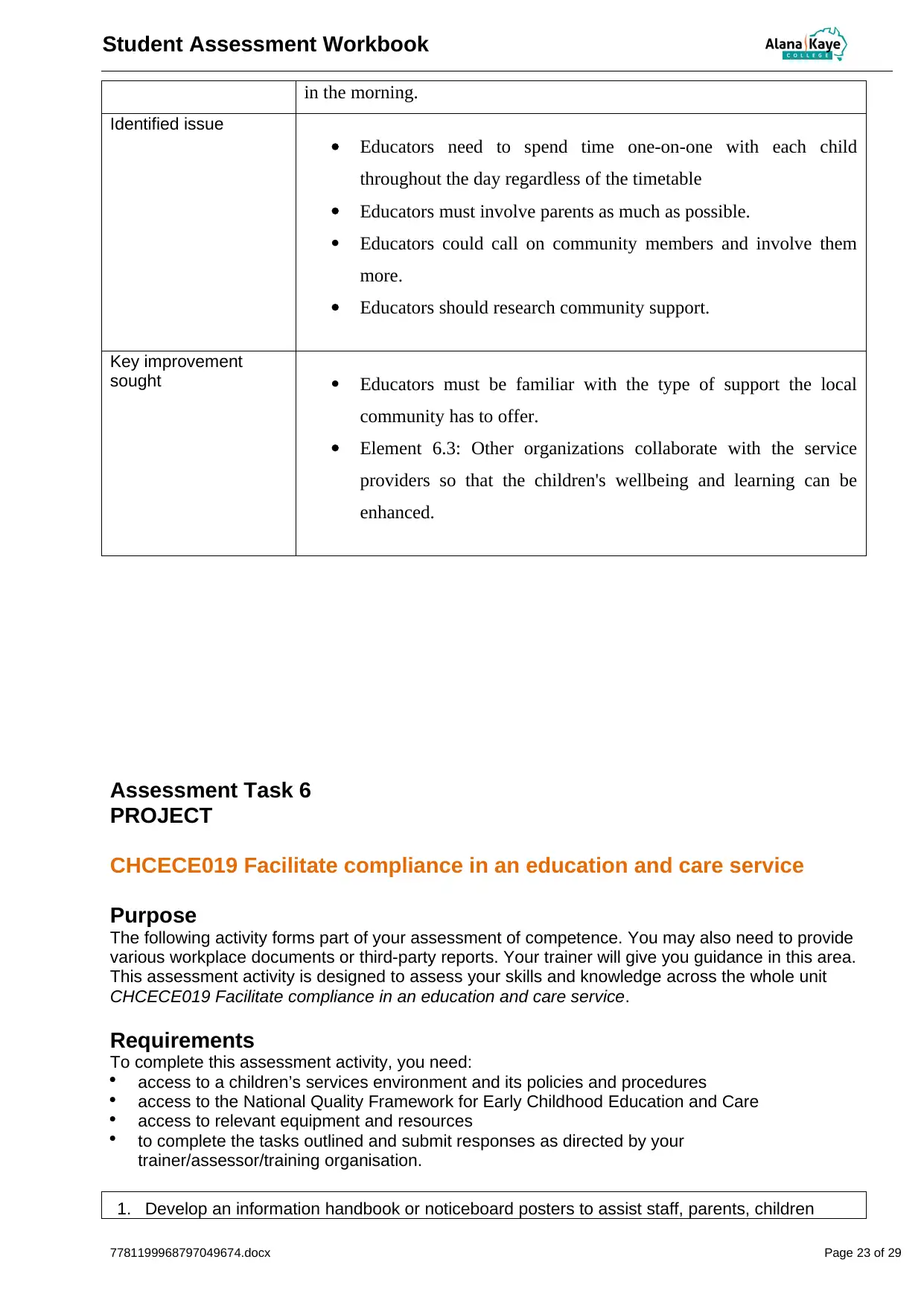
Student Assessment Workbook
in the morning.
Identified issue
Educators need to spend time one-on-one with each child
throughout the day regardless of the timetable
Educators must involve parents as much as possible.
Educators could call on community members and involve them
more.
Educators should research community support.
Key improvement
sought Educators must be familiar with the type of support the local
community has to offer.
Element 6.3: Other organizations collaborate with the service
providers so that the children's wellbeing and learning can be
enhanced.
Assessment Task 6
PROJECT
CHCECE019 Facilitate compliance in an education and care service
Purpose
The following activity forms part of your assessment of competence. You may also need to provide
various workplace documents or third-party reports. Your trainer will give you guidance in this area.
This assessment activity is designed to assess your skills and knowledge across the whole unit
CHCECE019 Facilitate compliance in an education and care service.
Requirements
To complete this assessment activity, you need:
access to a children’s services environment and its policies and procedures
access to the National Quality Framework for Early Childhood Education and Care
access to relevant equipment and resources
to complete the tasks outlined and submit responses as directed by your
trainer/assessor/training organisation.
1. Develop an information handbook or noticeboard posters to assist staff, parents, children
7781199968797049674.docx Page 23 of 29
in the morning.
Identified issue
Educators need to spend time one-on-one with each child
throughout the day regardless of the timetable
Educators must involve parents as much as possible.
Educators could call on community members and involve them
more.
Educators should research community support.
Key improvement
sought Educators must be familiar with the type of support the local
community has to offer.
Element 6.3: Other organizations collaborate with the service
providers so that the children's wellbeing and learning can be
enhanced.
Assessment Task 6
PROJECT
CHCECE019 Facilitate compliance in an education and care service
Purpose
The following activity forms part of your assessment of competence. You may also need to provide
various workplace documents or third-party reports. Your trainer will give you guidance in this area.
This assessment activity is designed to assess your skills and knowledge across the whole unit
CHCECE019 Facilitate compliance in an education and care service.
Requirements
To complete this assessment activity, you need:
access to a children’s services environment and its policies and procedures
access to the National Quality Framework for Early Childhood Education and Care
access to relevant equipment and resources
to complete the tasks outlined and submit responses as directed by your
trainer/assessor/training organisation.
1. Develop an information handbook or noticeboard posters to assist staff, parents, children
7781199968797049674.docx Page 23 of 29
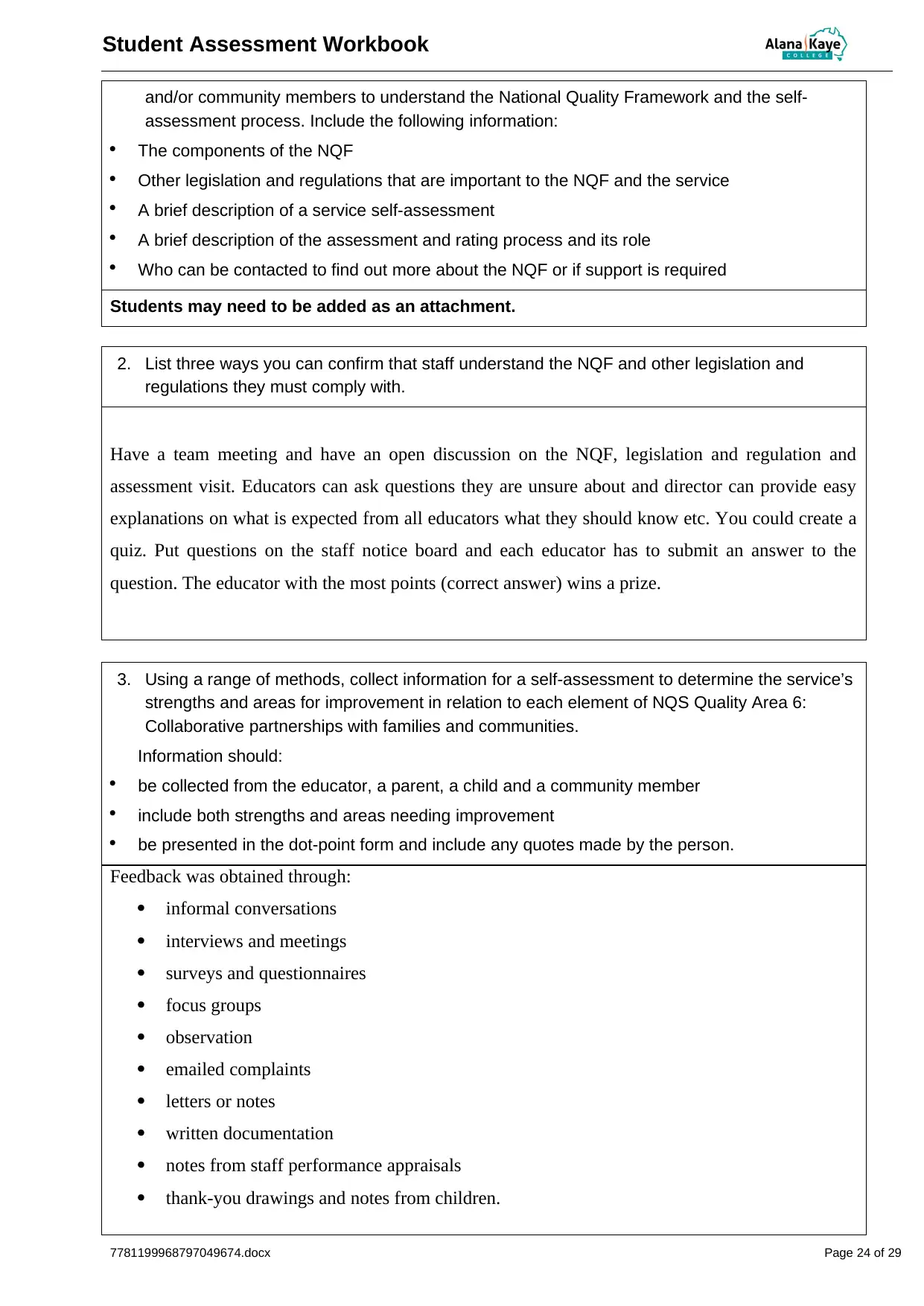
Student Assessment Workbook
and/or community members to understand the National Quality Framework and the self-
assessment process. Include the following information:
The components of the NQF
Other legislation and regulations that are important to the NQF and the service
A brief description of a service self-assessment
A brief description of the assessment and rating process and its role
Who can be contacted to find out more about the NQF or if support is required
Students may need to be added as an attachment.
2. List three ways you can confirm that staff understand the NQF and other legislation and
regulations they must comply with.
Have a team meeting and have an open discussion on the NQF, legislation and regulation and
assessment visit. Educators can ask questions they are unsure about and director can provide easy
explanations on what is expected from all educators what they should know etc. You could create a
quiz. Put questions on the staff notice board and each educator has to submit an answer to the
question. The educator with the most points (correct answer) wins a prize.
3. Using a range of methods, collect information for a self-assessment to determine the service’s
strengths and areas for improvement in relation to each element of NQS Quality Area 6:
Collaborative partnerships with families and communities.
Information should:
be collected from the educator, a parent, a child and a community member
include both strengths and areas needing improvement
be presented in the dot-point form and include any quotes made by the person.
Feedback was obtained through:
informal conversations
interviews and meetings
surveys and questionnaires
focus groups
observation
emailed complaints
letters or notes
written documentation
notes from staff performance appraisals
thank-you drawings and notes from children.
7781199968797049674.docx Page 24 of 29
and/or community members to understand the National Quality Framework and the self-
assessment process. Include the following information:
The components of the NQF
Other legislation and regulations that are important to the NQF and the service
A brief description of a service self-assessment
A brief description of the assessment and rating process and its role
Who can be contacted to find out more about the NQF or if support is required
Students may need to be added as an attachment.
2. List three ways you can confirm that staff understand the NQF and other legislation and
regulations they must comply with.
Have a team meeting and have an open discussion on the NQF, legislation and regulation and
assessment visit. Educators can ask questions they are unsure about and director can provide easy
explanations on what is expected from all educators what they should know etc. You could create a
quiz. Put questions on the staff notice board and each educator has to submit an answer to the
question. The educator with the most points (correct answer) wins a prize.
3. Using a range of methods, collect information for a self-assessment to determine the service’s
strengths and areas for improvement in relation to each element of NQS Quality Area 6:
Collaborative partnerships with families and communities.
Information should:
be collected from the educator, a parent, a child and a community member
include both strengths and areas needing improvement
be presented in the dot-point form and include any quotes made by the person.
Feedback was obtained through:
informal conversations
interviews and meetings
surveys and questionnaires
focus groups
observation
emailed complaints
letters or notes
written documentation
notes from staff performance appraisals
thank-you drawings and notes from children.
7781199968797049674.docx Page 24 of 29
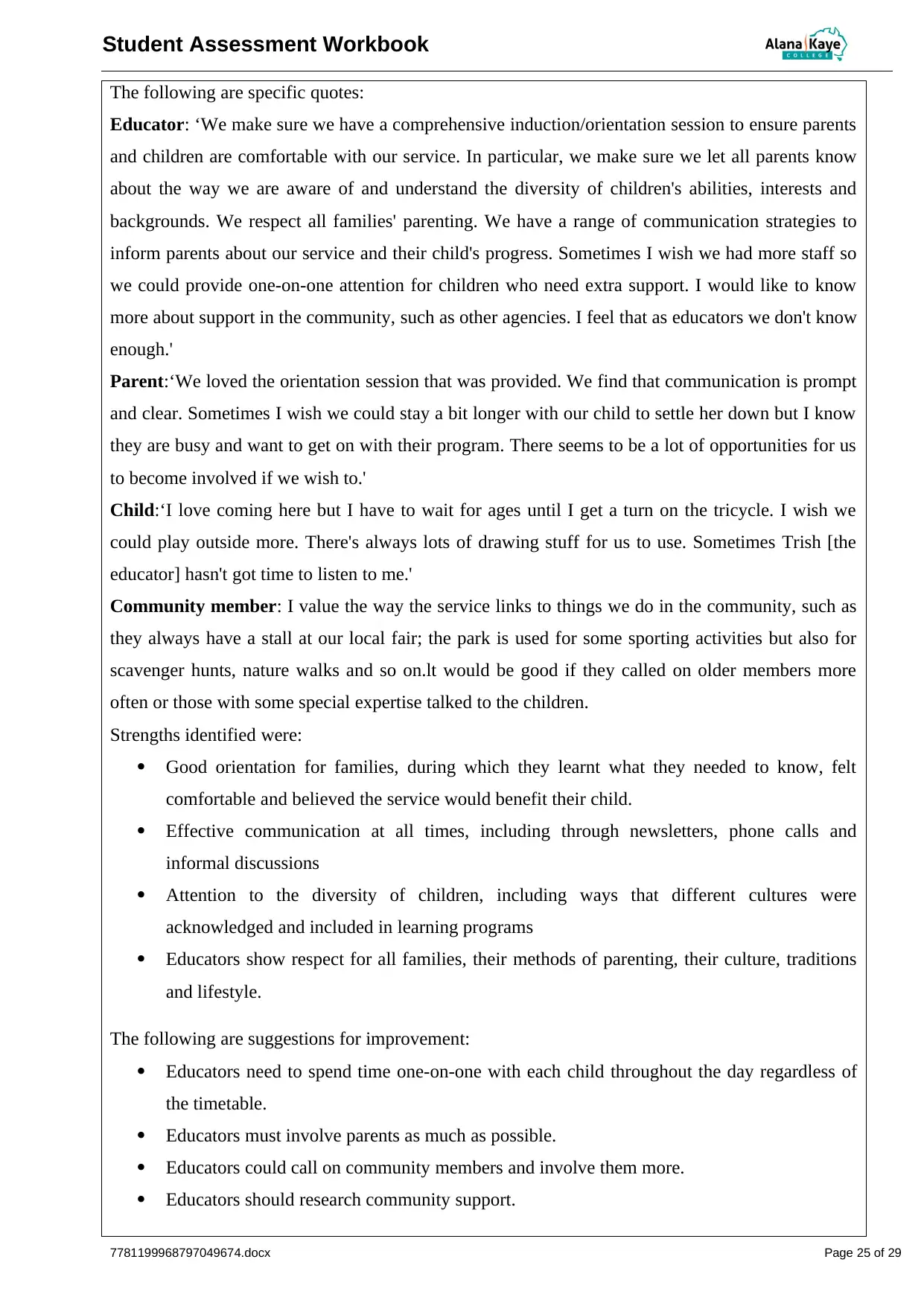
Student Assessment Workbook
The following are specific quotes:
Educator: ‘We make sure we have a comprehensive induction/orientation session to ensure parents
and children are comfortable with our service. In particular, we make sure we let all parents know
about the way we are aware of and understand the diversity of children's abilities, interests and
backgrounds. We respect all families' parenting. We have a range of communication strategies to
inform parents about our service and their child's progress. Sometimes I wish we had more staff so
we could provide one-on-one attention for children who need extra support. I would like to know
more about support in the community, such as other agencies. I feel that as educators we don't know
enough.'
Parent:‘We loved the orientation session that was provided. We find that communication is prompt
and clear. Sometimes I wish we could stay a bit longer with our child to settle her down but I know
they are busy and want to get on with their program. There seems to be a lot of opportunities for us
to become involved if we wish to.'
Child:‘I love coming here but I have to wait for ages until I get a turn on the tricycle. I wish we
could play outside more. There's always lots of drawing stuff for us to use. Sometimes Trish [the
educator] hasn't got time to listen to me.'
Community member: I value the way the service links to things we do in the community, such as
they always have a stall at our local fair; the park is used for some sporting activities but also for
scavenger hunts, nature walks and so on.lt would be good if they called on older members more
often or those with some special expertise talked to the children.
Strengths identified were:
Good orientation for families, during which they learnt what they needed to know, felt
comfortable and believed the service would benefit their child.
Effective communication at all times, including through newsletters, phone calls and
informal discussions
Attention to the diversity of children, including ways that different cultures were
acknowledged and included in learning programs
Educators show respect for all families, their methods of parenting, their culture, traditions
and lifestyle.
The following are suggestions for improvement:
Educators need to spend time one-on-one with each child throughout the day regardless of
the timetable.
Educators must involve parents as much as possible.
Educators could call on community members and involve them more.
Educators should research community support.
7781199968797049674.docx Page 25 of 29
The following are specific quotes:
Educator: ‘We make sure we have a comprehensive induction/orientation session to ensure parents
and children are comfortable with our service. In particular, we make sure we let all parents know
about the way we are aware of and understand the diversity of children's abilities, interests and
backgrounds. We respect all families' parenting. We have a range of communication strategies to
inform parents about our service and their child's progress. Sometimes I wish we had more staff so
we could provide one-on-one attention for children who need extra support. I would like to know
more about support in the community, such as other agencies. I feel that as educators we don't know
enough.'
Parent:‘We loved the orientation session that was provided. We find that communication is prompt
and clear. Sometimes I wish we could stay a bit longer with our child to settle her down but I know
they are busy and want to get on with their program. There seems to be a lot of opportunities for us
to become involved if we wish to.'
Child:‘I love coming here but I have to wait for ages until I get a turn on the tricycle. I wish we
could play outside more. There's always lots of drawing stuff for us to use. Sometimes Trish [the
educator] hasn't got time to listen to me.'
Community member: I value the way the service links to things we do in the community, such as
they always have a stall at our local fair; the park is used for some sporting activities but also for
scavenger hunts, nature walks and so on.lt would be good if they called on older members more
often or those with some special expertise talked to the children.
Strengths identified were:
Good orientation for families, during which they learnt what they needed to know, felt
comfortable and believed the service would benefit their child.
Effective communication at all times, including through newsletters, phone calls and
informal discussions
Attention to the diversity of children, including ways that different cultures were
acknowledged and included in learning programs
Educators show respect for all families, their methods of parenting, their culture, traditions
and lifestyle.
The following are suggestions for improvement:
Educators need to spend time one-on-one with each child throughout the day regardless of
the timetable.
Educators must involve parents as much as possible.
Educators could call on community members and involve them more.
Educators should research community support.
7781199968797049674.docx Page 25 of 29
Paraphrase This Document
Need a fresh take? Get an instant paraphrase of this document with our AI Paraphraser

Student Assessment Workbook
4. Develop a schedule or plan that would explain all the actions to take when you receive
notification that your service has begun the assessment and rating process.
Concentrate only on NQS Quality Area 6: Collaborative partnerships with families and
communities, as detailed in your QIP.
Include the actions you take:
prior to sending your quality improvement plan to the regulatory authority
prior to the assessment and rating visit, planned for four weeks’ time
on the day of the assessment and rating visit.
7781199968797049674.docx Page 26 of 29
4. Develop a schedule or plan that would explain all the actions to take when you receive
notification that your service has begun the assessment and rating process.
Concentrate only on NQS Quality Area 6: Collaborative partnerships with families and
communities, as detailed in your QIP.
Include the actions you take:
prior to sending your quality improvement plan to the regulatory authority
prior to the assessment and rating visit, planned for four weeks’ time
on the day of the assessment and rating visit.
7781199968797049674.docx Page 26 of 29

Student Assessment Workbook
7781199968797049674.docx Page 27 of 29
Timeline Step Process
Services background
processes
Service to familiarize themselves with NQF.
Service understands the seven National
Quality Standards.
NQS workgroups established
QIP is developed and implemented by
service
Start Notice via mail in regards to the fact that the
rating and assessment process has started.
The providers who have been approved will
have six weeks in which they have to submit
the plan to improve the quality to the
concerned authority.
The officer starts analyzing the available
information on the service which will
include the history of compliance and
National Childcare Accreditation Council.
Week 1 1 Working party for Quality Area 6 arranges a
meeting to review the QIP for this area. All high
priority goals are looked over and progress notes are
made.
Week 3 2 The working party gathers to analyse what the focus
is in relation to Element 6.3.2-To strengthen
positive transitions within our centre.
Week 6 3 The providers who have been approved will receive:
Receipt confirming the plan to improve the
quality
Clarification regarding the exact time and
date of the site visit
Week 7 4 The staff meeting is arranged to discuss with
all educators the process of the site visit day.
QIP for Quality Area 6 is discussed with all
educators at the staff meeting, seeking
feedback on Element 6.3.2.
7781199968797049674.docx Page 27 of 29
Timeline Step Process
Services background
processes
Service to familiarize themselves with NQF.
Service understands the seven National
Quality Standards.
NQS workgroups established
QIP is developed and implemented by
service
Start Notice via mail in regards to the fact that the
rating and assessment process has started.
The providers who have been approved will
have six weeks in which they have to submit
the plan to improve the quality to the
concerned authority.
The officer starts analyzing the available
information on the service which will
include the history of compliance and
National Childcare Accreditation Council.
Week 1 1 Working party for Quality Area 6 arranges a
meeting to review the QIP for this area. All high
priority goals are looked over and progress notes are
made.
Week 3 2 The working party gathers to analyse what the focus
is in relation to Element 6.3.2-To strengthen
positive transitions within our centre.
Week 6 3 The providers who have been approved will receive:
Receipt confirming the plan to improve the
quality
Clarification regarding the exact time and
date of the site visit
Week 7 4 The staff meeting is arranged to discuss with
all educators the process of the site visit day.
QIP for Quality Area 6 is discussed with all
educators at the staff meeting, seeking
feedback on Element 6.3.2.
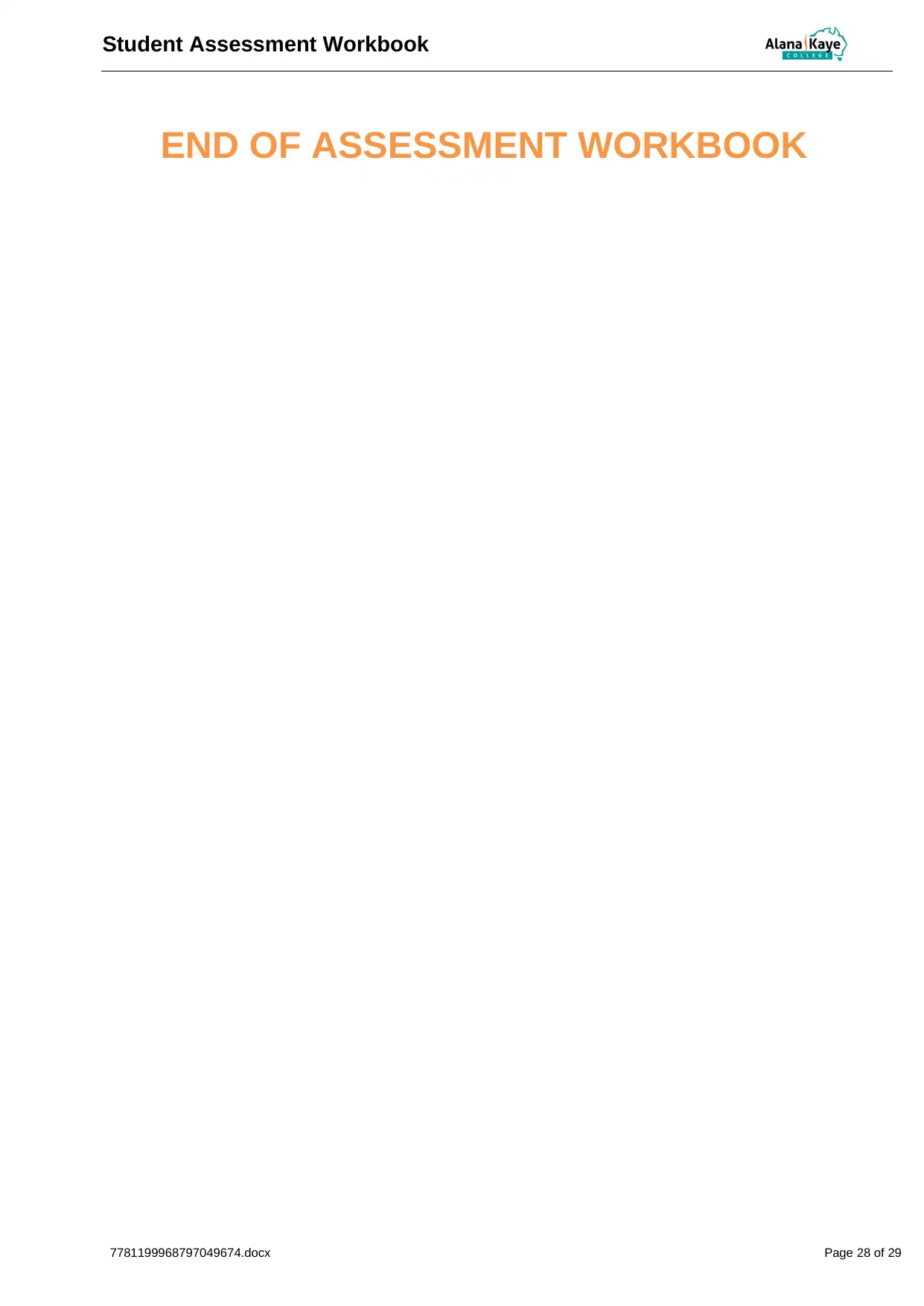
Student Assessment Workbook
END OF ASSESSMENT WORKBOOK
7781199968797049674.docx Page 28 of 29
END OF ASSESSMENT WORKBOOK
7781199968797049674.docx Page 28 of 29
Secure Best Marks with AI Grader
Need help grading? Try our AI Grader for instant feedback on your assignments.
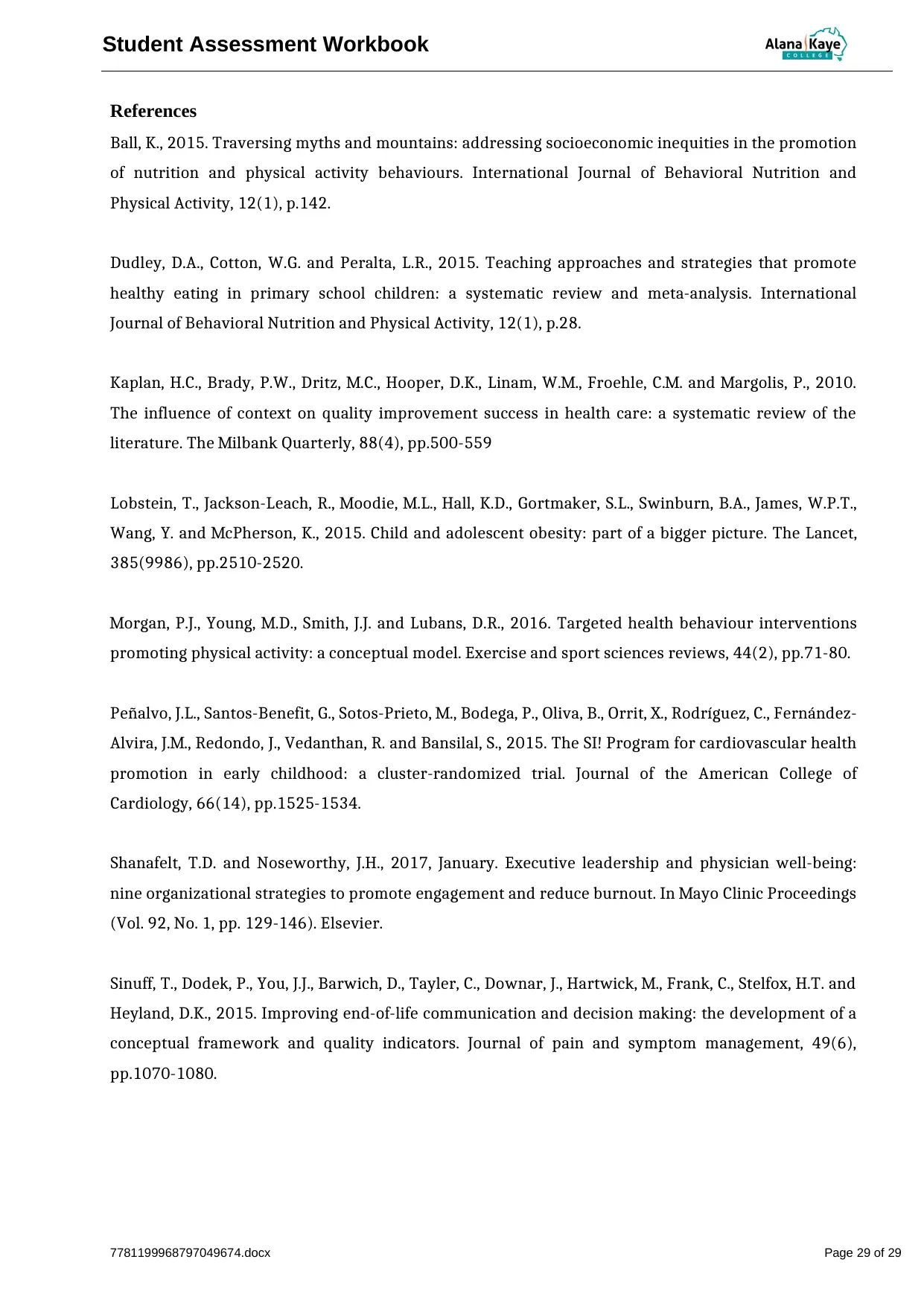
Student Assessment Workbook
References
Ball, K., 2015. Traversing myths and mountains: addressing socioeconomic inequities in the promotion
of nutrition and physical activity behaviours. International Journal of Behavioral Nutrition and
Physical Activity, 12(1), p.142.
Dudley, D.A., Cotton, W.G. and Peralta, L.R., 2015. Teaching approaches and strategies that promote
healthy eating in primary school children: a systematic review and meta-analysis. International
Journal of Behavioral Nutrition and Physical Activity, 12(1), p.28.
Kaplan, H.C., Brady, P.W., Dritz, M.C., Hooper, D.K., Linam, W.M., Froehle, C.M. and Margolis, P., 2010.
The influence of context on quality improvement success in health care: a systematic review of the
literature. The Milbank Quarterly, 88(4), pp.500-559
Lobstein, T., Jackson-Leach, R., Moodie, M.L., Hall, K.D., Gortmaker, S.L., Swinburn, B.A., James, W.P.T.,
Wang, Y. and McPherson, K., 2015. Child and adolescent obesity: part of a bigger picture. The Lancet,
385(9986), pp.2510-2520.
Morgan, P.J., Young, M.D., Smith, J.J. and Lubans, D.R., 2016. Targeted health behaviour interventions
promoting physical activity: a conceptual model. Exercise and sport sciences reviews, 44(2), pp.71-80.
Peñalvo, J.L., Santos-Benefit, G., Sotos-Prieto, M., Bodega, P., Oliva, B., Orrit, X., Rodríguez, C., Fernández-
Alvira, J.M., Redondo, J., Vedanthan, R. and Bansilal, S., 2015. The SI! Program for cardiovascular health
promotion in early childhood: a cluster-randomized trial. Journal of the American College of
Cardiology, 66(14), pp.1525-1534.
Shanafelt, T.D. and Noseworthy, J.H., 2017, January. Executive leadership and physician well-being:
nine organizational strategies to promote engagement and reduce burnout. In Mayo Clinic Proceedings
(Vol. 92, No. 1, pp. 129-146). Elsevier.
Sinuff, T., Dodek, P., You, J.J., Barwich, D., Tayler, C., Downar, J., Hartwick, M., Frank, C., Stelfox, H.T. and
Heyland, D.K., 2015. Improving end-of-life communication and decision making: the development of a
conceptual framework and quality indicators. Journal of pain and symptom management, 49(6),
pp.1070-1080.
7781199968797049674.docx Page 29 of 29
References
Ball, K., 2015. Traversing myths and mountains: addressing socioeconomic inequities in the promotion
of nutrition and physical activity behaviours. International Journal of Behavioral Nutrition and
Physical Activity, 12(1), p.142.
Dudley, D.A., Cotton, W.G. and Peralta, L.R., 2015. Teaching approaches and strategies that promote
healthy eating in primary school children: a systematic review and meta-analysis. International
Journal of Behavioral Nutrition and Physical Activity, 12(1), p.28.
Kaplan, H.C., Brady, P.W., Dritz, M.C., Hooper, D.K., Linam, W.M., Froehle, C.M. and Margolis, P., 2010.
The influence of context on quality improvement success in health care: a systematic review of the
literature. The Milbank Quarterly, 88(4), pp.500-559
Lobstein, T., Jackson-Leach, R., Moodie, M.L., Hall, K.D., Gortmaker, S.L., Swinburn, B.A., James, W.P.T.,
Wang, Y. and McPherson, K., 2015. Child and adolescent obesity: part of a bigger picture. The Lancet,
385(9986), pp.2510-2520.
Morgan, P.J., Young, M.D., Smith, J.J. and Lubans, D.R., 2016. Targeted health behaviour interventions
promoting physical activity: a conceptual model. Exercise and sport sciences reviews, 44(2), pp.71-80.
Peñalvo, J.L., Santos-Benefit, G., Sotos-Prieto, M., Bodega, P., Oliva, B., Orrit, X., Rodríguez, C., Fernández-
Alvira, J.M., Redondo, J., Vedanthan, R. and Bansilal, S., 2015. The SI! Program for cardiovascular health
promotion in early childhood: a cluster-randomized trial. Journal of the American College of
Cardiology, 66(14), pp.1525-1534.
Shanafelt, T.D. and Noseworthy, J.H., 2017, January. Executive leadership and physician well-being:
nine organizational strategies to promote engagement and reduce burnout. In Mayo Clinic Proceedings
(Vol. 92, No. 1, pp. 129-146). Elsevier.
Sinuff, T., Dodek, P., You, J.J., Barwich, D., Tayler, C., Downar, J., Hartwick, M., Frank, C., Stelfox, H.T. and
Heyland, D.K., 2015. Improving end-of-life communication and decision making: the development of a
conceptual framework and quality indicators. Journal of pain and symptom management, 49(6),
pp.1070-1080.
7781199968797049674.docx Page 29 of 29
1 out of 29
Related Documents
Your All-in-One AI-Powered Toolkit for Academic Success.
+13062052269
info@desklib.com
Available 24*7 on WhatsApp / Email
![[object Object]](/_next/static/media/star-bottom.7253800d.svg)
Unlock your academic potential
© 2024 | Zucol Services PVT LTD | All rights reserved.





